#they have more verticality and platforming in a game where the controls are the opposite of precise
Explore tagged Tumblr posts
Text
Every time I have the misfortune to need to visit one of the '''updated''' islands in Wild Horse Islands I'm like 'I am going to break into the dev's house, eat all the food in their 'fridge like an angry raccoon, and then tie them to a chair for a mandatory unskippable 10 hour powerpoint on level design starting from first principles because they clearly do not know a solitary goddamn thing about it.'
#I cannot believe how much WORSE they made LITERALLY EVERY ASPECT of all three of them#just like#what the actual fuck#they have more verticality and platforming in a game where the controls are the opposite of precise#they're harder to navigate#which is exacerbated by the verticality like it makes the maps useless you gotta memorize where shit is and how to get there#being able to see something doesn't mean you can get there unless it's below you and you're yeeting off a cliff#speaking of being able to see things; you fucking CAN'T because they put WALLS everywhere#why#whi#tea plays too many games
2 notes
·
View notes
Text
AI swimming, key/doors and "RUNAWAY"
After adding SWIM and CLIMB states, i tried adding SWIM states to the Companion but there's a catch.
I technically succeeded at adding swim states to the Companion (2 states equivalents to FOLLOWME and STANDSTILL so it can chase the Player underwater) but the one issue is that the character vibrates when on SWIMMING state.
My theory is that the movement is coded in a way that there's no proper diagonal movement, so it's actually switching between horizontal and vertical movement really fast.
It's what i get for simply copying Gonkee's Jared AI project without studying a bit further.
Because otherwise, it's technically "there" but it just looks off.
Key/Doors:
There's solid doors that block paths and keys that can be picked up to open them (With a basic red/blue/yellow color system).
Best part is that the Player's "has key" variables are false by default as a scene is loaded, so i don't have to check if the Player can or can't open a door without picking up a key first.
An issue (Besides maybe some notifier on the HUD/screen) is that i wanted to make Companions able to use keys but so far, it didn't work.
Which can be weird because stuff like the Health pickup and Jump pad work for both characters.
"RUNAWAY":
I simply thought "what if the Player will want the Companion to go forward without having to use FOLLOWME?" and created a "RUNAWAY" state/command.
It's essentially the opposite to FOLLOWME and could be useful in some scenarios.
Perhaps an issue here is the future controls of the game, since this will be a keyboard focused PC game unless i figure a way to set console controller inputs somehow.
It's also clear that the Companion AI will always be limited and impact level design in some way.
What else:
Pushable situation: Still on a break.
Maybe the "hurtbox/iframe" situation may also be on break.
Even in the main Github page, i've already written stuff that may need fixing in the future like if the health bars of both characters should be placed on the screen like a proper HUD.
But i've also been thinking on working on a level switch/button feature.
Something inspired by Pacman World where yellow/blue/green switches have specific functions based on their color.
Blue is "permanent", green is "toggleable" and yellow is timed (Not entirely like Pacman World but still).
The idea is that these switches are "modular" in the sense that in different levels, they can fill different effects and uses, even if this area is complicated.
I was thinking that at least, they could be related to moving platforms or something else besides doors because technically, the door stuff is already fulfilled by the keys (Maybe).
Unless i create different scenes for specific blocks/platforms with code based on receiving some signals and select some of those scenes for a level.
This also makes me wonder about the actual interaction:
If it's "automatic", the Player has to be carefull with when they touch the switch and if the Companion can bring a bit of trouble with pressing a switch in the wrong time.
If it's manual, i'd be setting up even more RayCast2D nodes and creating a new Input to make the control scheme more complex.
But this is just speculation.
I've seen a tutorial video where both a switch and door were under the same "scene" and the video used "editable children" to place each object uniquely in a level. But i'm pretty sure that "editable children" can impact a scene in general if i wanted to reuse it differently in multiple levels.
0 notes
Text
10 Games
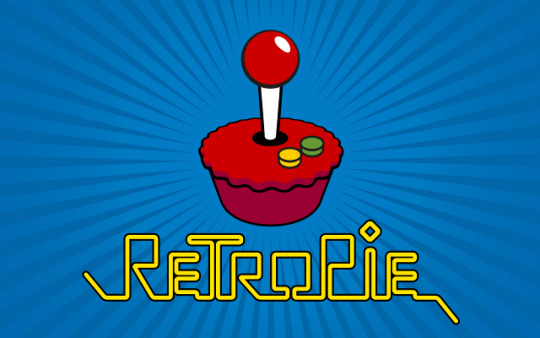
For Jack’s 10th birthday, Will got him a RetroPie. Pretty cool, especially since it’s so easy to just dump a zillion games in there and let the kid go nuts. But that’s a one-way ticked to analysis paralysis, so Will had a a super sick idea. He asked me and Jess and some other friends to put together a list of 10 must-play classic/retro games and write a little bit about why we chose them. As someone who loves video games and writing and lists, I was ALL ‘BOUT THAT.
Now that Jack’s birthday has come and gone, I can share all the junk I wrote about these ten games that mean so much to me! Check it out:
I love this idea. I know the initial prompt was just "pick your favorites" but I couldn't help but impose a bunch of additional caveats. I know where this list is headed (and I have a pretty good idea of what games will pop up on the other lists)! I could have easily listed off 10 Super NES games or 10 N64 games, but I wanted to hit a variety of consoles and franchises. I would have liked to have hit a variety of genres and studios too, but I can't lie: I love platformers, and I love games by Nintendo. It was challenging but rewarding to shave this list down to ten--a lot of old favorites and recent discoveries couldn't fit on the list, leaving these few. The ones I've always treasured, the ones that stuck with me, the ones I memorized the music and sound effects to, starring the characters I love, exploring the worlds I wanted to live in. Maybe you'll dig 'em too.
NES
Super Mario Bros. 3

I had spent some quality time with our Atari 2600 well before we ever had an NES in the house. I have fond memories of playing but not really understanding Pac-Man, Haunted House, and the bleak nuclear apocalypse masterpiece Missile Command. But the first game I really wrapped my head around was Super Mario Bros. (and Duck Hunt, but that's not as relevant!). Mario and Luigi's multi-screen adventures under a friendly blue sky expanded my concept of what a video game could even be--plus it was super fun, and Rochelle and I could both play it together! Super Mario Bros. 2 was technically more impressive, but so weird (and flanked by so many similar games) that it didn't rock my world like Mario 1 did (though I of course have a huge soft spot for it anyway). Then Super Mario Bros. 3 came along and Mario had learned how to fly. It was bigger, more beautiful, and stuffed to the brim with secrets and surprises! It was so exciting even Mom and Dad would play it with us. Super Mario World is maybe the bigger, better, beautifuler game (and you can ride a FREAKING DINOSAUR), but I'll never forget the day I woke up to find my dad and sister playing this in the living room because we finally owned it. It was too good to just keep renting! Kid Icarus
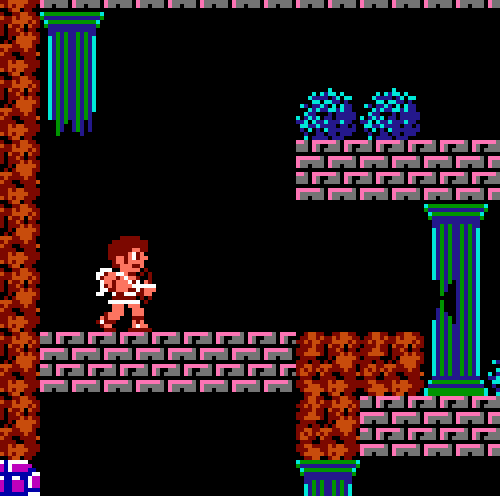
I didn't catch Kid Icarus the first time around. I didn't even play it until high school, but I was inspired to track it down because of my love for Greek mythology and the Metroid series. Kid Icarus takes place in a world heavily inspired by (but still distinctly different from) the swords, sandals, and sorcery epics of ancient Greece! It's considered a "sister game" to the original Metroid, released around the same time by the same team, and the game shares a lot of the core elements that make Metroid so unique and awesome: eerily lonely, dangerous worlds to explore, a challenging beginning, player-empowering character growth, and a focus on exploring vast, often vertically-scrolling worlds with satisfying run'n'gun'n'jump gameplay. Kid Icarus borrows all the best stuff from Metroid, but tempers it with a slate of unique design choices: instead of one sprawling world, KI is split into discrete levels. The first world is an ascent out of Hades with vertically oriented levels, the second world is a horizontal trek across the surface world, the third is another vertical ascent into the sky, and the finale is a horizontal, forced-scrolling shoot-em-up to reclaim the heavens! Every fourth level is a sprawling, maze-like, Metroid-ish dungeon, capped off with a frantic boss fight! Plus, Eggplant Wizards, credit cards, and RPG-style character upgrades! They don't make 'em like this anymore!! Duck Tales

It's not as groundbreaking as Super Mario Bros. 1 or as innovative as Super Mario Bros. 3, but that doesn't change the fact that Duck Tales could possibly be my favorite NES platformer of all time. You don't need to know anything about or even like the original cartoon (or the comic books that birthed it) to appreciate the challenging charms of this hop'n'bop classic. Duck Tales only has a handful of levels, but they're huge, full of hidden treasures, packed with alternate paths, swiss cheesed with secret passageways, and just gorgeous translations of Disney's lush cartoon worlds. Getting to choose your own path through Duck Tales' roster of big beautiful worlds is reminiscent of the Mega Man games (also by Capcom). What really sets Duck Tales apart is controlling Scrooge. He's spry for a septuagenarian billionaire, but his real talents lie in swinging and pogo-sticking off his cane! It's delightful cartoon nonsense, but if you get the hang of it, it's also incredibly satisfying, allowing you to make some wild, death-defying maneuvers. If you dig this and find yourself hungering for more bounce-centric gameplay, Shovel Knight takes Scrooge's cane, turns it into a shovel, and builds a deeply satisfying modern classic around it. Donkey Kong Country: Tropical Freeze finally gives Cranky a chance to shine as a playable character, and he straight-up jock's Scrooge's style, cane and all. It rules.
Super NES
Yoshi's Island

The first thing you'll notice about Yoshi's Island is that it looks like it was drawn with crayons, markers, and colored pencils! The second thing you'll notice is that Mario is a freaking baby! It's an odd premise, but it all comes together in perhaps the best sidescroller ever made. With Mario mustache-less and diaper-clad, this game puts you directly in control of Yoshi, and he is a joy to play as. Hovering to extend his jump power, turning enemies into eggs and chucking them, and butt-stomping are Yoshi's primary tools of the trade, and they mix things up nicely. This doesn't feel like "just another Mario," but it also feels right at home in the Mario pantheon. Beyond the Yosh-man's most basic maneuvers, there are some wild power-ups that turn Yoshi into a helicopter, a train that zips along in the background, a mole-tank, and more, plus special areas where Baby Mario gets superpowers and runs up walls and stuff! Yoshi's Island is another magical micro-world, jam-packed with extremely clever and fun level design and very possibly the biggest and best boss fights of all time. Ya gotta play this one.
Donkey Kong Country 2: Diddy's Kong-Quest
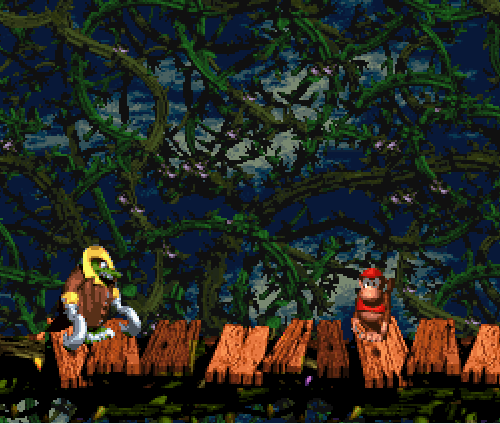
I know I just talked about Yoshi's Island maybe being the best platformer of all time, but Donkey Kong Country 2 is right behind it, nipping at its heels. DKC2 has a wildly different aesthetic, dropping you into beautifully computer-rendered pirate shipwrecks, janky-but-glitzy night time carnival rides, endless bramble patches, a skyscraper-sized beehive, haunted forests, and more! They're not just beautiful to look at, but beautiful to listen to, because DKC2 features one of the all-time greatest video game soundtracks. Maybe the greatest. But this game ain't just another pretty face!
DKC2, like Super Mario Bros. 3 and Duck Tales, is stuffed to the gills with tricky little secrets and hidden areas and surprises. This game doesn't just have secret levels, it has a secret WORLD. This game doesn't just have a secret world, it has an entire secret ENDING. The classically solid platforming is accompanied by a wealth of mine cart challenges, awesome animal buddies, mini-games, and enough level design variety to keep you coming back for every last hidden treasure.
Super Metroid
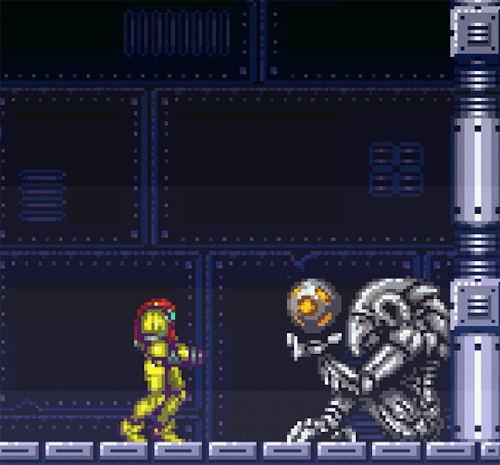
Super Metroid doesn't just have secrets, it has mysteries. This was the first game to ever actually scare me. The first one to ever creep me out. And that just made me want to play it even more. It feels lonely and dangerous. Unlike the games earlier on this list, it is one HUGE and continuous world. It is a world of incomprehensible alien horrors, ancient moldering ruins, and high-tech space-faring bio-terrorists. This world, named Zebes, is a world where the sky continuously rains acid and almost every living thing inhabiting it wants to kill you. Good thing you're Samus Aran, the toughest, smartest bounty hunter to ever clean up Space Pirate scum!
Samus explores this acid-drenched nightmare planet by running, gunning, and jumping... but also by solving puzzles and thinking her way out of traps. With each power up she gets a little stronger, and can find her way deeper into this gnashing alien hellscape. It's a game that is sadly beautiful just as often as it is ghoulish. The story, simple and sketched-in as it is, is also deeper and more moving than you will ever expect. The boss fights are as massive, memorable, and epic as the ones in Yoshi's Island, but about a thousand times more intense and frightening. The music perfectly sets the dark, burbling mood of each region of Zebes, and by the end of the game you will feel like the most powerful hero in the galaxy. This mix of sci-fi, horror, and adventure isn't just a must-play, it's a life-changer.
Gameboy Color
Wario Land II
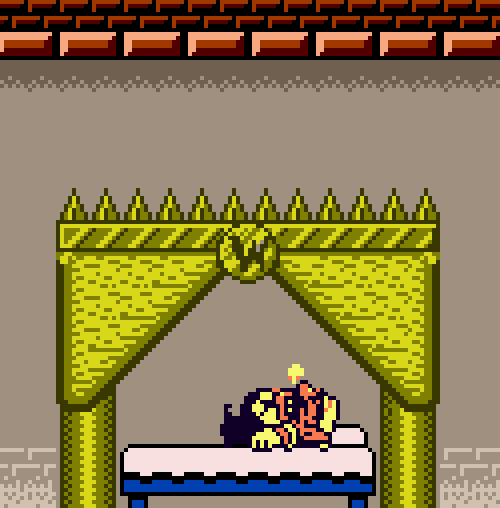
I love the Mario series, but I'm also absolutely crazy about Wario. He's a fat, greedy, chaotic, prideful, disgusting, bull-headed oaf. He's the polar opposite of Mario... and that's why I love him! He's not exactly a villain, but he's a definitely a troublemaker, and it is hilariously fun to walk (or stumble!) a mile or three in his shoes. The game before this, Super Mario Land 3: Wario Land is a ton of fun (as is Super Mario Land 2 before it!), but Wario Land II is the first one that truly feels like a Wario game. What makes this game so different? Wario can't be killed!
You read that right, there's (almost) no way to actually "die" in this game! No way to lose lives. That might sound too easy, or boring, or both, but it's not! Wario might be unkillable, but all KINDS of bad stuff can and WILL still happen to him. A LOT. He'll get flattened, set on fire, trapped in bubbles, fattened up, frozen, drunk, zombified, and more! And here's the kicker: those wacky conditions are required to solve the puzzles and challenges of each level! On top of that ingenious and perfectly wacky set of game mechanics, the story branches off in wildly different directions: you'll blow up the annoying alarm clock in your castle, play street basketball against a giant bunny, be nice to a chicken, visit Atlantis, race through a weird world of mouths, noses, and eyes, and more! There are multiple endings, multiple hidden exits, and multiple secret treasures and minigames to find and conquer. Almost all of the Wario Land and Wario Ware games are oddball masterpieces, but WLII is the perfect balance of weird, smart, funny, and challenging.
Nintendo 64
Super Mario 64
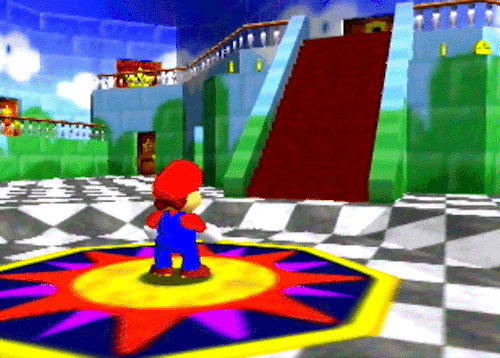
This is it. This is the game. In 1996, when I was in sixth grade, Super Mario 64 was the only thing I cared about. I begged and wished and hoped for a Nintendo 64 that Christmas, but it didn't come. I was crushed. Occasionally I was able to rent an N64 and Super Mario 64, and I'd lose whole days to this magical, miraculous game. When I couldn't rent it, I'd bug my classmates about it endlessly. "What level are you on? What's that level like? What stars can you get? What secrets have you found?" They'd answer a few of my ravenous, bug-eyed questions before getting uncomfortable and leaving to do something else. What was the big deal? Why was I (and still am) so obsessed?
The leap from Super Nintendo to Nintendo 64 was like the leap from console and computer games to virtual reality. But instead of short, funny minigames, it is a huge, sprawling world where anything seems possible. A magical, secret garden full of surprises, wonder, challenges, and secrets. Where the sun always shines in a cloudless sky... except when you plunge into the death-defying Bowser levels or the inappropriately terrifying Big Boo's Haunt. Oh Mario can definitely fly in this one like he did in Super Mario Bros. 3, but just the simple act of running around in circles and jumping through 3D space felt like a joyous miracle... one that puts 2-dimensional flight to shame. Each world (accessed by jumping INTO paintings in Princess Peach's sprawling but empty castle) is colorful, full of possibility, and chock full of distinct personality. Adventuring through 3D space for the first time ever was incredible on its own, but doing it in such richly detailed, lovingly crafted worlds made me want to play there forever. I still do.
The Legend of Zelda: Ocarina of Time

Take everything I just said about Super Mario 64 and multiply it by ten! Well, sort of. Ocarina of Time took the lessons learned from Super Mario 64 and applied them to the dungeon-crawling, puzzle-solving Legend of Zelda series. The result was an incredibly groundbreaking game that I cherished almost as zealously as Super Mario 64. I don't think it's aged as well, but I don't care. Ocarina of Time is a grand story, spanning seven years (!!!) and the entire fantastical country of Hyrule. As Link, you jump forward and back through time, meet strange and wonderful new friends, discover hidden kingdoms, face the blood-soaked evil of Hyrule's past, save its future, outwit cunning puzzles and traps, steal and ride a magnificent horse, challenge towering, Super Metroid-style end bosses, wield magical weapons, break hearts, play beautiful music, and go fishing. It's an entire, epic fantasy life in one little cartridge.
This was the first Zelda game I ever spent SERIOUS time with, and the fact that it plays like a fantasy-fueled hybrid of Super Mario 64 and Super Metroid means I've lost entire days to it. I've played it start to finish at least 8 or 9 times. It never gets boring. Like Super Mario 64, Ocarina of Time invented how we make and play 3D games. This was the first 3D game where you could lock onto enemies and points of interest, plus a bevy of other camera controls that come standard in 3D games now (or at least they did for about a decade after Ocarina's release). The story is surprisingly cinematic and even gripping at times. You'll want to live in this world. You'll be sad when you see the end credits. Not because of the ending itself, but because there's no more game for you to play... until you start it all over again on the next save file.
Star Fox 64
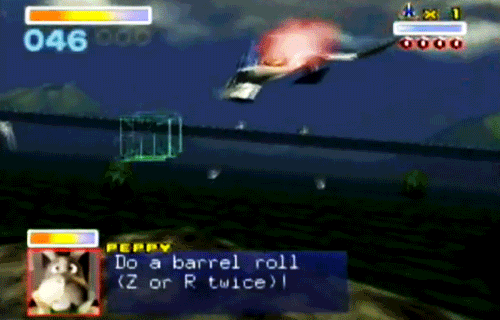
Star Fox 64 was a life-changing event for me, just like Super Mario 64 and Ocarina of Time. So is Star Fox 64 a slow-paced, exploration heavy adventure into beautiful and fantastical solitude like those other two games? N O P E. It's a guns-blazin', fast action, dogfightin', barrel rollin', rock'em sock'em intergalactic action epic in supersonic spaceships! Piloted by talking animals! That actually talk! YES!
Instead of the wide-open freedom of Super Mario 64 and Ocarina of TIme, Star Fox 64 either puts you on (invisible) rails in a forced-scrolling attack run or in a contained 3D arena. Here's the kicker though, the levels are all so perfectly designed and the action is so expertly paced that you never feel restricted. You're too busy racking up kill combos, saving your wingmen, and navigating through flying, burning space debris and buildings and asteroids and terrain to think about what you can't do. And even on rails, Star Fox 64 gives you ways to explore! Most levels have multiple exits and there are a whole mess of different, branching paths through the entire, war-torn Lylat system. The game is designed to be played start to finish in a single sitting, but experimenting with repeat playthroughs is the only way to experience everything this laser-blazing action classic has to offer. On top of all that, it's got a great story, iconic, meme-worthy dialogue, and an absolutely banging soundtrack. It might not have changed the face of interactive entertainment like Super Mario 64 and Ocarina of Time, but it delivered the ultimate shoot'em up space adventure.
4 notes
·
View notes
Text
Rio 2016 Olympics: Artistic Swimming, A Review
Synchronized Swimming used to be known as 'water ballet'. This is because the routines are essentially a series of athletic movements choreographed to a piece of chosen music. Not unlike staged ballet, except that it is performed in the water. Synchronized Swimming is highly challenging, requiring ease of movements and the ability to stay upside down in water. it is said to be as hard to practice as it is beautiful to watch. A test even for strong swimmers, the sport requires advanced water skills, strength, flexibility, endurance, grace, precise timing, artistry, and exceptional breath control.
In this blog, I will be reviewing the court dimensions, equipment, basic skills, technical and tactical skills of each team, rules of the game, and how to officiate artistic swimming in the 2016 Olympics, officially known as the Games of the XXXI Olympiad and commonly known as Rio 2016, was an international multi-sport event held from the 5th to the 21st of August 2016 in Rio de Janeiro, Brazil.
COURT DIMENSIONS
The pool must be at least 20m wide x 30m long, and at least 2.5m deep. One area, 12x12m or larger, must be at least 3m deep and the slope between the change in depths has to be completed over a distance of 8m or less.
The pool's water must be clear enough so that the bottom of the pool is visible from above and at least 27°C (80.6°F,) plus or minus one degree. The amount of light underwater is also very important, since goggles aren't worn in competition, so there is a required minimum brightness of 1500 lux.
EQUIPMENT

Hair gel or gelatin
Nose Clip
Underwater Speaker
Costume
BASIC SKILLS
The basic skills you will need in synchronized swimming is sculling and treading water with a kick called the "eggbeater". There are also many positions that you can learn to combine into a routine. Additionally, there is an element known as “lifts” in synchronized swimming, where swimmers create a structure of sorts with their bodies and lift themselves from the water in the same formation they created underwater.
Sculls
Sculls are hand movements used to propel the body and are essential to synchronized swimming. Some commonly used sculls are support, standard, torpedo, split-arm, barrel and paddle scull. The support scull is most often used and is made up of two repeated movements. You need to hold your upper arms against your body and your forearms at 90-degree angles. Then, you move your forearms back and forth to create enough water pressure to hold your legs above the water.
Eggbeater
This move is much like how a manual eggbeater works, with one leg rotating in a clockwise manner and rotating the other leg in an anti-clockwise manner. Synchronized swimmers use this kick because it leaves their hands free to perform strokes. Due to the opposite motion of the kick, it is a stable and efficient way for swimmers to attain the necessary height to perform moves above the water.
Positions
There are hundreds of positions that can be used to create infinite combinations. The six most common positions are illustrated below.
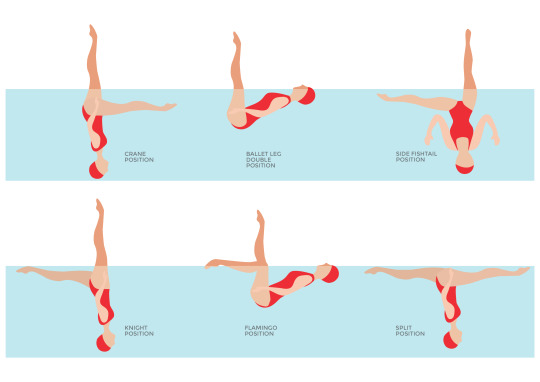
Crane Position - Hold your body in a vertical position with one leg held vertically above the water surface, while the other leg is held parallel under the surface in a 90-degree angle or "L" shape.
Ballet Leg Double Position - From lying flat on the water surface, draw your knees towards your chest with shins parallel to the water surface. Straighten your legs above the water surface to assume a Surface Ballet Leg Double position.
Side Fishtail Position - This is a position similar to the crane. One leg remains vertical, while the other is extended to the side parallel to the water, creating a side "Y" position.
Knight Position -The body is held vertically with your head in line with the hips and pointed to the bottom of the pool. One leg is lowered to create a vertical line perpendicular to the surface.
Flamingo Position - Similar to the ballet leg position where the bottom leg is pulled into the chest so that the shin of the bottom leg is touching the knee of the vertical leg.
Split Position - With the body vertical, one leg is stretched forward along the surface and the other leg is extended back along the surface.
Lifts
Lifts are formations that are formed underwater and as swimmers propel themselves towards the surface, they stay in formation and add more elements like acrobatics. There are three parts to a lift in synchronized swimming: The Flyer, the Base and the Pushers.
The Flyer - Flyers are agile and flexible and are usually the smallest member of the team. It is preferable that they have a gymnastics background as they need to perform complicated moves while on the top of the formation.
The Base - Base swimmers tends to be small in size, but should have good leg strength and a solid core as they make up the structure of the formation.
The Pushers - Pushers are the bigger and stronger swimmers because they need the strength to propel the formation to the water surface.
Types of Lifts
The Platform Lift - The base lays out in a back layout position underwater, where they lie on their back to form a platform of interlinked bodies. The Flyer sets in a squatting position and stands once the lift reaches the surface. The remaining teammates use the eggbeater kicks to hold the platform and the flyer out of the water.
The Stack Lift - Considered to be an updated version of the Platform, the Stack Lift begins with the base squatting while underwater, supported by the pushers. The flyer then stands on the shoulders of the base. The pushers and base gradually stretch out their limbs, elevating the flyer. A rotating descent is usually added to this lift.
TECHNICAL AND TACTICA; SKILLS OF EACH TEAM
EGYPT
Execution: 23.5000; Artistic Expression: 31.4667; Difficulty: 23.6000; Penalty: 0.0; Technical Routine: 76. 9838; Free Routine: 78.5667 Total Score: 155.5505
They were the first performer and at first I wasn’t sure whether or not I will be enjoying while watching the video but their intro stunned me. It was my first time watching synchronized swimming and I did not know they would walk in sync and dive in different times and their dive was very beautiful. They did uniquely beautiful lifts while executing various leg choreographies and positions.
AUSTRALIA
Execution: 22.6000; Artistic Expression: 20.1333; Difficulty: 22.7000; Penalty: 0.0; Technical Routine: 74.0667; Free Routine: 75.4333 Total Score: 149.50
Their synchronization and timing is very nice. Their performance was unique and it was a fun routine. I was amazed by their hand movements in their choreography because it was very fun to look at. From what I’ve seen they used a variety of sculls in order for them to perform the different kinds of positions such as the flamingo position and the split position.
ITALY
Execution: 27.5000; Artistic Expression: 37.0667; Difficulty: 27.7000; Penalty: 0.0; Technical Routine: 91.1142; Free Routine: 92.2667 Total Score: 183.3809
With their theme which was seasons of earth, I was amazed by how elegant, and sweet their performance were. It was almost like a fairytale. They were able to maintained balance, fantastic synchronization, and unique formation of lifts. Their synchronization was very intense especially during their feet formations in their choreography. I was awed by all of their fantastic formations.
BRAZIL
Execution: 26.1000; Artistic Expression: 34.8000; Difficulty: 26.3000; Penalty: 0.0; Technical Routine: 84.7985; Free Routine: 87.2000 Total Score: 171.9985
When the song started, I was kind of hesitant in watching their routine because I thought it wouldn’t be as good as the ones that have finished performing. However, I was in awe by their excitingly fun choreography which was a good epitome of carnival. Very smooth and excellent synchronization, very artistic. I love their facial expression and their formation are also very excellent accompanied by the song. I love the spins after they do the knight position during their formations. I love the hand choreography they did from 30:07- 30:36. Their handwork in practicing their choreography really paid off because they look so great underwater as they unfold the next move from another. I love how they look like they are having so much fun they don’t even look fatigued but watching them they stole my breath away by how difficult and fun their routine was. Their routine lived up to their theme of carnival. They executed all the moves well, a lot of spirit and energy, and the high-risk of balance from the lifts especially in the part of Christo! shout of the song. Very charismatic.
RUSIAN FEDERATION
Execution: 29.7000; Artistic Expression: 39.7333; Difficulty: 29.7000; Penalty: 0.0; Technical Routine: 97.0106; Free Routine: 99.1333 Total Score: 196.1439
Their theme was angels and when I heard the intro of the song it sounded so intense and when they started off with an opening lift well...it was very incredible that watching the recap, there wasn’t any mistakes and their lifts are difficult but stunning to watch. Their synchronization is perfect, energy and explosive power of moves is so incredible. The song was a bit suspenseful, and their moves perfectly accompanied it. Their formation is brilliant and unique. I love their lifts and how the girl that was lifted turned beautifully as she descends to the water at 37: 18. Even their work underneath the water is beautifully synchronized. I love their facial expressions too during their beautiful lifts. No wonder they won gold medals.
UKRAINE
Execution: 28.2000; Artistic Expression: 38.2667; Difficulty: 28.7000; Penalty: 0.0; Technical Routine: 93.4413; Free Routine: 95.1667 Total Score: 188.608
Right from the start, they immediately showed difficult routines, and when they showed their underwater movements, they were all so synchronized when they do hand movements to propel their bodies in order to execute leg positions for their routine. I love the shapes they showed. The actions they show require high risk but I love how it looked. They performed intense and risky moves and they do it fast too but they are good at it so the outcome of their movements are breath-taking.
CHINA
Execution: 29.1000; Artistic Expression: 39.0667; Difficulty: 29.2000; Penalty: 0.0; Technical Routine: 95.6174; Free Routine: 97.3667 Total Score: 192.9841
From their intro pose, they are already showcasing their flexibility as their theme is finding dragon. The power of the lift right from the start was very beautiful and high, the pushers and the base must’ve worked so hard with it in order for their flyer to be able to execute it so perfectly. They performed complicated moves afterwards which was so fascinating to see. Their synchronization is very powerful, and the way they interpreted their theme by using lifts was very great to see. They quickly change formation and then perform uniquely amazing choreographies with very beautiful twists. Their formation is just absolutely beautiful. The way they matched their legs movement with the intense music was so amazing at 54:01 onwards. No doubt they deserve the silver medals.
JAPAN
Execution: 28.5000; Artistic Expression: 38.1333; Difficulty: 28.8000; Penalty: 0.0; Technical Routine: 93.7723; Free Routine: 95.4333 Total Score: 199.2056
Right from the start they immediately performed two lifts which was very beautiful. The formation was very artistic and they performed it cleanly. They also performed a fun choreography and I was completely absorbed by their music because it sounded both cute and fun. The lifts are just beautiful especially when they end it with turns.
RULES OF THE GAME
No Touching the Bottom
One of the things which makes the lifts all the more impressive is that artistic swimmers are not allowed to touch the bottom of the pool at any point during their routines.
No Bling
Presentation is a unique and important part of artistic swimming but there are certain restrictions on what swimmers can wear. For example, artistic swimmers are not permitted jewelry, theatrical make-up, or inappropriate costumes.
No Goggles
Another restriction during artistic swimming routines is goggles. However, swimmers in figures competitions are permitted to wear them.
Team Means Team
Teams normally contain eight swimmers, but the minimum number for a team is four. Teams lose marks for every swimmer they have under the full complement because it is easier to synchronize the fewer people there are in a routine.
Stick to The Schedule
Routines can be anything from two and a half minutes to five minutes long, depending on whether they are performed alone or as part of a team. However, swimmers are penalized if they take 15 seconds fewer or longer than the specified time.
HOW TO OFFICIATE THE GAME
Timekeeper
The role of a timekeeper is to check, and record, the overall times of the routines and of the deck movements. If the time limit for the deck work is exceeded or there is a deviation from the permitted routine time allowance, the timekeeper advises the referee.
Clerk of the course
The role of a clerk of the course is to organize the competitors so that they are ready for their events at the required time. During figure competitions, they ensure that the swimmers are in the correct order to perform their figures.
Scorer
The role of a synchro scorer is to record marks from the judges and make the necessary computations for each routine. There are two levels of synchro scorer – national scorer and chief recorder.
National scorers write down and manipulate all the scores that come in for figures and routines at competitions. They can officiate at any level of domestic competition including the National Age Group Championships and ASA National Championships.
Chief recorders are in charge of scoring at synchronized swimming events. They are trained to manage related computer results systems at national and regional competitions.
Judge
Synchro Judges are essential for running synchronized swimming competitions as they provide scores based on the performance of each routine. They are also responsible for marking grade level assessments. To reduce the level of subjectivity in scoring, all synchro judges must be expertly-trained. They require a full understanding of FINA and the ASA’s rules and regulations for synchronized swimming competitions.
There are three levels of Judge:
Level 1: Candidates must be 16 years old to take the level 1 judge course. They will be qualified to judge at level 1 and 2 competitions. The course includes:
Use of marking scales
Develop understanding of basic movements and positions
Able to identify Figures in current age groups (12U and 13/14/15)
Ethics
Develop knowledge and understanding of Free Routines
Knowledge of Grade 1 and 2 criteria and assessment criteria
Level 2: Candidates must have been a level 1 judge for at least a year. They will be qualified to judge at regional competitions at the National Age Group Championships. The course includes:
In-depth knowledge of Junior Figures (15-18 years)
Develop knowledge of rules and penalties
Develop knowledge of NVT, difficulty values and application to figures. Application of deductions to figures
Exposure to variety of level of figures and scores
Knowledge and awareness of Grade 3/4/5 criteria
Further analysis of Free Routines – range of level of routines, recognition of difficulty
Level 3: Candidates must have been a level 2 judge for at least a year. They will be qualified to judge at the National Championships. The course includes:
Further knowledge about rules, penalties and organization
In-depth knowledge about judging Figures and component parts
Further develop knowledge and aptitude regarding judging Free Routines
Awareness of Grade 6 criteria
In-depth knowledge of technical elements across solos, duets and team
Referee
The role of a synchro referee is to oversee the control of a synchronized swimming competition. The referee makes sure all aspects of the event are run smoothly and follow FINA rules.
____________________________________
Bibliography
An Introduction to Artistic Swimming. (n.d.). Retrieved from Swim England Artistic Swimming: https://www.swimming.org/artistic-swimming/introduction-to-artistic-swimming/
Basic skills and positions in Synchronised Swimming. (n.d.). Retrieved from Active SG: https://www.myactivesg.com/Sports/Aquatics/How-To-Play/Synchronised-Swimming/Basic-skills-and-positions-in-Synchronised-Swimming#:~:text=The%20basic%20skills%20you%20will,to%20combine%20into%20a%20routine.
Lutz, R. (2016, July 22). Synchronized swimming 101: Equipment. Retrieved from Archive PyeongChang: http://archivepyc.nbcolympics.com/news/synchronized-swimming-101-equipment
Officials in synchro. (n.d.). Retrieved from Edinburgh Synchro: http://edinburghsynchro.co.uk/officials-in-synchro/
Synchronized Swimming Pool Dimensions. (n.d.). Retrieved from SwimOutlet.com Guides: https://www.swimoutlet.com/guides/synchronized-swimming-pool-dimensions#:~:text=The%20pool%20must%20be%20at%20least%2020m%20wide%20x%2030m,distance%20of%208m%20or%20less.
0 notes
Text
David's Personal Top Ten Video Games
This is something I've been wanting to do for a long time. It is a personal list, reflecting the games that have stuck with me the most over the years. I'm not enough of a gamer to claim it is anything comprehensive, and it has a strong bias to the sorts of genres that I like. Nonetheless, I'd stack these games against any that have been made in my lifetime. Anyway, without further adieu ....
Honorable Mentions:
Portal 2: How can a game with virtually no “dialogue” (if that means conversations between two characters) have some of the best spoken lines in all video game history? I have both the original and a capella versions of the Turret Opera on my iTunes (yes, I have “Still Alive” as well).
Railroad Tycoon II: A brilliant simulator that makes you actually feel like a turn-of-the-century robber baron (by far, the game is most fun to play when set in the late 19th century). If every man goes through his “trains!” phase, this was mine. As in real life, I am not good at playing the stock market.
Horizon: Zero Dawn: Robot dinosaurs! Incredibly, Horizon: Zero Dawn takes a core concept that sounds like word association from an over-caffeinated twelve-year boy and makes an entirely serious game about it—and it works. It works so well, in fact, that I loved it despite the fact that the plot and entire world-building background centers around my single greatest phobia (no, not that—being alive for the extinction of humanity).
10. Sid Meier’s Gettysburg: I find it odd that very few games have sought to replicate Gettysburg’s spin on an RTS—focusing combat around regiments rather than individual units and prioritizing morale over raw numbers. But the thing I like best about Gettysburg—and sadly it’s mostly unique too—is in how it concentrates on controlling territory (and terrain). Many RTS games, for me, might as well have a blank screen over 80% of the map between my base and my opponent’s base. You build up your force, and then try to swarm your opponent before he or she swarms you. But in Gettysburg, the goal of missions is not “wipe out your opposition”. It’s to capture and hold a ridge, or dig in and hold an exposed farmhouse.
My only critiques are that I want this game to be bigger. I want it to encompass dozens of map spanning the entirety of the Civil War. I want to be able memorize even more obscure Union and Confederate generals and wonder if they really were “mediocre” or if that was just a game balance decision. The random battle generator is okay, but this game screams for user-created expansions which I’ve never been able to find.
9. Crimson Skies: A pulpy fun flight simulator taking place in an alternate history 1930s where America has fractured and Zeppelin travel rules the day. The game doesn’t hesitate to lean into its concept (phrases like “broad” and “floozy” abound), and it does a great job world-building in a relatively short period of time. Somehow, I could meet an enemy “ace” for the first time in the middle of a mission and yet still feel like we had a history of epic dogfights together of which this was only the latest. Meanwhile, each of the locations the game takes you to (Hawaii, the Pacific Northwest, Hollywood, the Rocky Mountains, and New York City) are a blast and a half.
A sequel, High Road to Revenge, was released on Xbox and leaned a little too hard into the arcade-y elements (power-ups, automatic evasive maneuvers with the press of a button, and so on). But the original PC game was just right—planes flew exactly like how someone who knows nothing about planes thinks planes fly, which is just perfect. You felt like an ace pilot because of your skill (even though behind the hood the game is really holding your hand). Piloting a gyrocopter through half-built New York City skyscrapers, or a prototype single-engine through the Hollywood "O", is great. Doing it to evade local security, then doing a loop and turning both guns on them -- well, that's the cat's meow.
8. Mass Effect (Trilogy and Andromeda): As far as I’m concerned, the definitive space opera (even muscling out Halo). Fabulous voice acting (listening to Martin Sheen play evil Jed Bartlett is one of the great joys of my life) and memorable plot lines pair with a morality system that at least inches away from “basically decent person or utter asshole.” The universe feels genuinely alive, like there’s an ecosystem and civilization that you’re very much apart, but also moves in your absence.
I can’t really separate out the core trilogy games from one another (each sequel seemed to simultaneously step slightly forward and back), which is not I think an uncommon position. What may be more uncommon is that I think Andromeda stands right in there with the core series. Yes, it was disappointing that it took us to a brand new galaxy and only gave us two new species (while eliminating many of the more backgrounded Milky Way aliens). But I was much more disappointed that there will be no DLC or sequels to continue the story and tie up loose ends.
7. N and N++: There can’t be any serious controversy that N is the greatest Flash game ever made. While Flash demands simplicity, N is not so much simple as it is elegant. It is the perfect balance of speed and control, thoughtfulness and twitch-trigger reflexes, serene relaxation and butt-clenching tension. Once you master the floaty physics and the unique enemy styles, you will truly feel like a ninja—stripped to its core essence and deprived of all the usual but unnecessary bells and whistles. A virtually unlimited supply of levels guarantees you endless gameplay.
And so it is unsurprising that N was one of the rare flash games that made a successful jump to a full true game (in the form of N++), one that has a strong claim on being the greatest platformer ever made. The developers were wise not to disturb the basic formula: run, jump, and slide around a level, dodge obstacles and traps that will kill you instantly, reach the exit. Repeat ad infinitum. But N++ adds just a splash of additional flavors and spices into the mix. A perfect trip-trance soundtrack that sets the mood perfectly (and may single-handedly stave off keyboard-smashing frustration). A few new enemy types that deepen the game without ruining its austere grace. And perhaps most importantly, it adds a bunch of extra, semi-secret challenges (which can be used to unlock still more levels) waiting for the very best-of-best players.
Of all the games on this list, I might be in absolute terms “best” at N++ (there are a non-trivial number of levels in the game where I have a top 100 or even top 10 score on the global leaderboards). And yet there is not the slightest chance that I will ever perfect this game, or even come close to it. Nor is there any chance I will become permanently sick of it. A simple concept, executed brilliantly. The perfect N++ level is also the perfect description of the game.
6. Final Fantasy IX: The question was never whether a Final Fantasy game would make this list, only which one. I’ve long had a soft-spot for FFIX, which I feel is often overlooked inside the series (in part because even on release it seemed players were already looking ahead to the Playstation 2). Yet it’s hard to find fault in Final Fantasy IX as an emblem of a straight-forward JRPG. It has a moving story, fun gameplay, beautiful music, loads of quests to do and places to explore, a fabulous supporting cast (Vivi might be my favorite Final Fantasy character ever written), and a lead character you don’t want to punch (*cough* Final Fantasy X).
Final Fantasy IX is often described as “nostalgic”, and despite the fact that it was only the second game in the series I had ever played, I got that feeling instantly. Try listening to the soundtrack for “Frontier Village Dali” without feeling a little melancholic. You don’t even have to have played. But I recommend that you do.
For the record, my ranking of Final Fantasy games that I’ve played goes: IX, VII, XII, XV, X, XIII.
5. Assassin’s Creed: Brotherhood: One difficulty in judging games within a series is how to compare an earlier game which still had some rough edges but represented a quantum leap forward versus a later game which didn’t do anything super-novel but tweaked the formula to perfection. That, in a nutshell, is the difference between Assassin’s Creed II and Assassin’s Creed: Brotherhood. Now, for me, this is an easy call for idiosyncratic reasons—I played AC:B before AC II, and so I experienced the former as both the perfected model and the quantum leap forward as compared to the original game. But I respect that for those who played the series in order, this is a harder call.
What should be easy for anyone is to agree that together, Assassin’s Creed II and Assassin’s Creed: Brotherhood represented the AC series reaching its full potential. Ezio continues to be the best protagonist the series has seen to date. Renaissance Italy likewise is the ideal setting for both AC’s vertical and horizontal platforming elements and its shadowy-conspiracy/secret-history plotline. As a franchise, Assassin’s Creed really launched the parkour/open-world exploration genre, and Brotherhood was the first game where every single element of what that genre could be came together. Other more recent games have been tons of fun (Black Flag and Syndicate are I think highlights), but these two games are the reason this series is so iconic.
4. Might and Magic VI: The same problem posed by AC2 versus Brotherhood emerges with Might and Magic VI and VII—except here, I did play them in order. Like the previous entry, I do think that VII ultimately improves upon the formula set out in Might and Magic VI. It’s more versatile, has more replay value, a touch more balanced (and that’s not getting into ArcoMage) … all in all, probably a better technical game.
But Might and Magic VI is for me iconic—it may well be the first RPG I’ve ever truly loved (and given the way this list is stacked in that direction, that’s saying a lot). Virtually all the things that characterize what I love in games today, it had in at least skeletal form. Open world exploration? Check: It was the first game where I felt like I was a true pathfinder—meticulously crawling over every corner of the map to find each obscure bandit’s cave and goblin fortress. To this day I still have the lay of the land in Enroth basically memorized. Overly detailed worldbuilding text to read? Absolutely: my obsessive-streak came out in reading every single artifact description, conversational option, and quest backgrounder (it is canon that Enroth, and the entire planet it resides upon, was blown up in a magical explosion—a fact I’m still resentful towards 3DO for long after it disappeared into bankruptcy). Slight genre-bending? The splash of Sci-Fi onto the fantasy setting was delightful to discover for someone who had never played any of the prior entries in the series. And some of the music—well, the White Cap theme is a thing of beauty, and on my computer “Adagio in G Minor for Strings and Organ” is still listed as “Church Dungeon Music.”
3. Heroes of Might and Magic III: If comparing earlier, more revolutionary games against newer more polished ones presents a problem in the Assassin’s Creed and Might and Magic series, it presents no trouble at all in Heroes of Might & Magic. That’s because the third installation in the series both represented a huge jump forward from what came before and is unquestionably the best entry in the overall sequence.
Sure, some of the expansions are a bit goofy, but they still work—sharpshooters and enchanters are massively overpowered, but they’re generally used in missions that would otherwise be impossible. But the main campaign is fabulous—a surprisingly intricate and interwoven plot that bridges Might and Magic VI and VII compliments outstanding strategy gameplay. And that doesn’t even get into the acre of standalone maps provided, plus countless more available on the web thanks to a map editor so intuitive, even I can use it (I’m terrible with map editors).
As a result of all of this, Heroes III is maybe the only game on this list that can compete with N++ regarding infinite replayability. This is fortunate, because—given the fact that Heroes III was a full-budget release and was not supposed to be “simple”—it ages incredibly well. Even the graphics hold up (no need for that remastered remake—which doesn’t even include the expansions!).
2. Witcher III: As you may have noticed, this list has a strong bias towards RPGs. My preference is toward “Western” RPGs (which have a go-anywhere/do-anything exploration mentality) compared to “Japanese” RPGs (which are more linear and story-driven), but Witcher III does an incredible job of synthesizing the best of both. It has a huge open world to explore, one that feels alive and dynamic—but there is also an incredibly rich story filled with deep, well-written characters (of which Geralt—the player character—is but one).
Gameplay-wise, Witcher III really hits the perfect balance. I simultaneously felt like the biggest bad-ass in the room, but also like a single slip in concentration or bit of overconfidence and my corpse would unceremoniously end up at the bottom of whatever cave I was in. But Witcher III particularly stands out in how it subverts certain common RPG tropes. You are a hero, but you’re not particularly well-liked. You’re a powerful warrior, but you’re still ultimately treated as a pawn in larger political machinations. Your interventions do not always save the day, and sometimes don’t even make things better. If a mission starts with a villager worrying that their beloved has gone missing, nine times out of ten that person has been devoured by a monster well before you ever get there. While many games claim to place the hero in difficult moral dilemmas, Witcher III is a rare case of following through (some games might give you the choice to let a trio of witches eat a group of kids whom you recently played hide-and-seek with, but few make it so that might actually be the more moral of the options in front of you). There’s even a quest where you help a knight rescue a lady in distress from a curse, then lecture him that he’s not entitled to her romantic attention as a reward (talk about a timely intervention in the video game genre!). Over and over again, the game reinforces the message that being really powerful and doing “the right thing” isn’t enough to fix a fundamentally broken system.
Most impressive is the emotional impact that Witcher III dishes out. Sometimes this is a result of rich character development that pays off over the course of the entire game (as in “The Last Wish” quest). But sometimes it shows up in even relatively minor sidequests—the epilogue of the “Black Pearl” quest was one of the more brutal emotional gut-punches I’ve experienced in a video game. Ultimately, this was a game where one always felt like each character was a person—they were imperfect, they had their own interests, hopes, dreams, strengths and foibles, and while you were a little better with a sword and gifted with some preternatural abilities, you were still only one player in a much bigger narrative. As a result, Witcher III might well be, in my estimation, the perfect RPG.
Oh, and Gwent is ludicrously addictive. Let’s not forget that.
1. TIE Fighter: I don’t think this list has a particularly “modern” bias. Still, there’s something impressive about the number one game on this list also being the oldest by some measure. TIE Fighter originally came out in 1994, and the definitive Collector’s Edition was released in 1995. It is, to this day, one of the best games ever made. And that’s not a retrospective assessment. Star Wars: Tie Fighter holds up even played right now.
For starters, it is one of the few elements of the Star Wars universe to get the Empire right. I’m not saying that the Empire is the real protagonist of the series. I am saying that they wouldn’t view themselves as evil—as much as naming spacecraft “Executor” and “Death Star” might suggest otherwise. TIE Fighter is quite self-assured in presenting you as being a force for law and order in the galaxy, battling not just seditious rebels but pirates, smugglers, and other anarchic forces that threaten to tear civilized life apart.
Let’s start with something often overlooked in TIE Fighter: the music. It’s probably the only context that the phrase “kick-ass MIDI soundtrack” makes sense. But that’s not even the half of it. The iMuse system dynamically and seamlessly arranges the musical cues to reflect what’s going on around you in the mission—you can literally follow important mission updates (e.g., a wingman being shot down, or reinforcements arriving) simply by the way the melody shifts. I’m not sure I’ve ever encountered anything quite like it since. To this day, the number that accompanies an incoming enemy capital ship fills me with exhilarated dread.
Gameplay-wise, TIE Fighter is almost shockingly rich. The core mission requirements are challenging, but by no means out of reach. But embedded in each level are a series of secondary and secret bonus objectives. These unlock a parallel plot of the Emperor’s Secret Order—but always present a brutal risk/reward calculus. That’s not unrelated to the fact that you’re often flying, well, TIE fighters (not noted for their durability)—but the challenge extends well beyond physical peril. TIE Fighter actually gives you an “invincibility” option if you want it, and yet even with it on some of the later missions and bonus objectives will strain every piloting skill you’ve ever developed.
Most importantly, the secret objectives usually are more involved than “blow up everything in sight.” They reward initiative and exploration. Maybe your primary mission objective is to destroy a rebel space station. But just before it goes down, you spot an escape shuttle fleeing the station. Take it out? Maybe—but maybe the occupants are VIPs best taken alive. So you switch to ion cannons and disable it for capture. Yet that extra time you just spent has given the rebels enough breathing room to summon reinforcements—now an enemy cruiser is bearing down on you. Take out its missile launchers and clear path for bombers while praying that your own Star Destroyer will arrive soon to back you up. All on the fly. All while dogfighting starfighters, dodging mines, giving your wingmen orders … it’s insanely, beautifully chaotic.
Did I mention this is all happening in 1995? 90% of games released today don’t have that kind of depth or spontaneity. In terms of playability, replayability, and just plain fun, TIE Fighter stands alone, and unchallenged.
via The Debate Link https://ift.tt/2HbDTEl
3 notes
·
View notes
Photo

Summary: Two years after Banjo and Kazooie defeated Grunty, her sisters come to set her skeletal corpse free. Seeking to drain the life force from the land to give herself a new body, the bear and bird set out on an adventure across the Isle o' Hags to stop the witch once again.
Overall: I could use a lot of fancy quotes here. “Size matters not”, “Brevity is the soul of wit”, and “It’s about the journey not the destination”. All of these in one way or another paint a picture of this game. It’s larger in scale, but not as tightly designed. It generally feels like tasks are drawn out to the point of feeling like busy work, and most importantly the tasks themselves just aren’t fun. If you still somehow like this game good for you, because once upon a time I did to, even more than the original. Those days are long gone. Banjo Tooie in my mind is a text book example of how not to handle a sequel. It’s worth looking at for that reason alone, but it’s not a game I’d recommend playing.
What follows after the break while organized is probably a jumbled mess. This review was written over several weeks in short bursts and as a result I may not get to something I said I would or in other cases I might repeat or contradict myself.
Controls: All of the controls of the original make the jump to the sequel. From the moment the game starts you have access to all of the moves from the original. The only notable change is that swimming and flying controls have been inverted from what they were. At least on XBLA.
As far as other controls go it’s incredibly hit and miss. The game introduces FPS segments that on XBLA finally have modern controls as opposed to the legacy controls of the N64. The biggest failure of the new controls is separated Banjo. Without Kazooie in his back pack all of the old crouch moves are open up to use. None of them are though. Instead one by one the entire right stick is taken over by the moves as if it was the C-buttons on the N64. What’s funny is that Kazooie doesn’t have that problem at all. Her separate move set doesn’t touch the right stick. They really dropped the ball hard on Banjo.
Gameplay: Banjo Tooie plays for the most part the same as the original. You collect Jiggies and Musical Notes just like the previous. Only difference is the purpose. Instead of spending Jiggies to open new worlds you’ll instead need a certain total to unlock a puzzle challenge to open the next. This forces you to unlock every levels in order. Musical Notes aren’t spent, but they also don’t open doors, at least not directly. Instead you’ll need a certain Note total to be able to learn moves from Jam-jars, Bottles brother. Mumbo Tokens are gone. Instead they are replaced with Globows. These magical creatures are two per world and a single one will be used to play as Mumbo or use Humba Wumba’s transformation in that world. Jinjos are still five per world, but collecting all 5 isn’t a guaranteed Jiggy. Each time you start a new game all of the Jinjos are shuffled and you get a Jiggy for collecting all of the ones of a single color.
Now you may be asking yourself “how can that work?” Don’t Jinjos reset when you leave a world along with your notes? Well not in this game because back tracking. Banjo Tooie is a series of interconnected worlds and its sense of place between them all is impressive from a design stand point. I however don’t find it to be fun. In fact in most cases it’s the opposite. Banjo Tooie has its simple backtracking like bringing a move back to open up a challenge, but that’s sadly the minority. Almost all challenges are massive multipart endeavors. Now Kazooie had these, but it was only in its final world. Here that shit starts at level three and just keep getting more complex. There are always single world challenges, but they’ve become the minority.
A massive interconnected world isn’t a bad idea on paper, but the issue is the level design itself. The worlds are big and empty. While each level has 100 Notes, Notes are collected in nests of five with a super special 20 note nest. This means despite much larger worlds there is 17 Notes to collect as opposed to 100, or even 200. There is a lot of dead space in these worlds. Baddies respawn, but even those are few and far between. They’re also less creative. Sure there is the occasional interesting foe, but for the most part they all function the same. The levels are also just a pain to navigate. They generally follow a ring shaped design like the original, but the challenges are inside rooms off to the side. I remember the rooms themselves well enough, but remembering which tunnel leads to which room I’ve never been able to pull off. It’s almost as if this game was designed to force you to look at maps in some sort of guide. Even the new warp pads aren’t enough to make this bearable.
New Moves: With every button combination on the N64 controller already used how do you grow the bear and birds move set? The answer is to make new contexts in which moves can be learned. The Bear and Bird’s new move set is almost entirely context sensitive maneuvers or modifications of the old moves. The duo gain a ledge grab, a modified beak buster, an underwater special switch hitting move, four new egg types, two new pairs of boots, first person egg aiming for land, air, and sea, first person shooting, melee while first person shooting, and splitting the pair up which offers even more moves for each.
You’ll note how repetitive a lot of that sounds. You learn 4 new ways to shoot eggs in the first person. Both of the new boots are used for vertical movement. The first is an extra powerful jump that makes it essentially a semi mobile spring shock pad. The other lets you climb walls
I’ll bring it up whenever it hits in the levels section, but these new moves create a series of gates. Because Banjo can’t do certain things, like fly for instance, you can’t go certain places without Kazooie. These sound fine on paper, but there is a gigantic issue with it in action, and that’s the back tracking. I’m going to make the controversial statement that DK64 did this better. In Tooie you must be switching to and from the combination of Banjo and Kazooie. The split pair can’t transform at Humba Wumba’s or let Mumbo go out for a run. You also can’t transform as Mumbo or ask Mumbo as a transformed duo. Without a centralized character swap point you end up spending most of your time switching characters, something that took seconds in DK64.
Other Differences: Foes respawn in this game unlike the original. This is because more often than not you’ll be treading over old ground with no real platforming or challenge to it so they need the façade of something interesting. Lives are also gone, but that wasn’t really that big an issue in the original. Banjo’s punches were replaced with a peck from Kazooie, but did anyone ever use the punches? Eggs and feathers are found in nests with their contents cycling every couple of seconds. With a total of five egg types this makes getting the type you want a huge pain in the ass while with feathers it kind of breaks the value of the golden feather and its invulnerability.
Story: If Tooie has one thing that hurts it as much as helps it it’s the story. Grunty is saved by her sisters and after two years of decay was left a skeleton. Boy who cried wolf tropes lead to Bottles getting caught in a blast from the presumed dead Witch killing him. Grunty heads to what I assume is her sisters’ lair where she plans to absorb all the life from the Isle o’hags to give herself a new body. The jump in effort isn’t massive, but the game has more cut scenes on both ends of it. Now why would this be a detriment to the game? Well its emphasis on Grunty being more of a character means that early on they drop her rhyming. That really sucks.
Music: One thing I can’t complain about is the music. Grant Kirkhope still nails it. The soundtrack is one I actually own on disk. I don’t know how many tracks here were carry over from Kazooie, but considering most of the levels were I’d assume the soundtrack was as well. The music is more of the same and in regards to music that can only be a good thing.
Worlds:
Spiral Mountain: Like in its predecessor, Spiral Mountain is a tutorial, but for the entire last games move set. You aren’t given a prompt to skip however, but aren’t required to go through the tutorial either. Instead you can just walk to the new found hole in the wall to start up the game’s first boss fight. Klungo, Grunty’s mistreated minion, waits to ambush you and serves as a road block to make sure you get the basics before jumping into the new stuff.
A few things will have you coming back later including Stop’n’swop or its sequel as well as Cheato, a Jinjo, and Roystien. Cheats instead of being hidden are unlocked by returning 5 Cheato Pages to Cheato in the entryway to Gruntilda’s lair. The rest are all hidden by new moves and exploration.
Isle o' Hags: Technically the entire game is set here, but this is all the less specific parts. This is what replaces Grunty’s lair, and despite being outdoors it feels and is a lot smaller. Every entryway to a world in the original was grand and bombastic and had a room all to itself. Here that applies to the first three. After that everything is shared and the grand entryways become more or less just doors. Level 4 being one of the most dull in the history of level entrances. It’s a hole in a boring wall with a sign and arrow.
Isle o’hags is also where you’ll learn all four new egg types. While two of these are pretty cool, the other two are pretty damn pointless. The Fire and Ice eggs are used very little. They’re mostly for the penultimate level with maybe two or three different use cases each outside of it. The Grenade and Clockwork Kazooie eggs are both explosives, the former working like a basic grenade and the latter dropping a tiny wind up bird that can slip in small holes to blow stuff up. Now to be fair the use cases for these aren’t super varied either, but these are used in more ways than just shoot this egg type in the hole. Grenades blowing up walls gets pretty old, but it’s at least different. Clockwork Kazooie eggs have the issue of being one of two small hole related entry methods that aren’t well differentiated between.
Now earlier I mentioned how there are no note doors, at least not directly. Instead moves are locked behind notes and world progression requires new moves. You need the Ledge grab to get to the second level so you’ll II need to find it in the first level. You need fire eggs to reach the third level. You need to be able to split the duo up to reach the fourth level which is found in the third. This cycle continues up until level 6 where you’ll learn the last move locking off areas. Of course to get that move you are also required to beat a boss but oh we will get to that level.
Mayahem Temple: Level one is fine. It’s backtracking is no worse than it for in Banjo Kazooie. You need Mumbo to open up the side two large side rooms which will lead to Humba Wumba. Only one Jiggy requires coming back later and it’s due to a move you get in the next world which is also used here to get a Jiggy back there. Oh yeah you’ll be doing things in worlds X, Y, and Z to get Jiggies in world A.
Its design is sort of ring like. You follow a main path up top around a central cliff with the titular temple atop it. Two large doors can be found that Mumbo will open once you reach him at the top. Most of the content is inside these side rooms which seems much more common in this game than the previous. Sadly a lot of this content feels repetitive. Twice you’ll sneak across noisy surfaces. Two Jiggies are in the temple FPS tutorial.
Humba Wumba turns Banjo into a living Stone statue that lets him compete in three progressively more complicated games of soccer for a single Jiggy. The Stoney can talk to other living stone statues that can help you get a few other Jiggies, but he doesn’t get that much use considering how big this level is.
Despite how small and barren the world feels it somehow still takes me an hour to beat, and I know what I’m doing. It’s just really drawn out. It’s the least offensive level but that’s not saying much.
Glitter Gulch Mine: This is as close as Banjo has gotten to a Western inspired world and it’s also a dropped level from Banjo Kazooie. Why it was dropped is pretty clear. It’s a labyrinthine mess. While Mayahem Temple has just two similar looking doors, this level has at least half a dozen. The level is so bad that they’ve got some of these rooms labeled so you don’t enter the wrong room. Most of your time will be spent trying to figure out where the hell that thing was again so you can do the challenge.
The design of the level follows a single mine-cart track between two rooms, a Train station and Fuel Depot. Between the two is various side tunnels and not enough notable land marks to make navigating it easy. Luckily not much will make you back track here. You’ll only need to come back for a single Jiggy and that’s it. You’ll need to hit several areas as Mumbo and Humba’s worst transformation ever to open things up for Banjo and Kazooie.
This world’s most notable move is the Bill Drill which is the modified beak buster. Holding Z or a Trigger instead of tapping it will make Kazooie drill the ground instead of slam into it. This can break rocks and later on loosen screws. Of all the moves in the game this one feels the most underused.
Now what is this awful transformation? A TNT blaster. You’ll use it to blast open TNT barrels blocking some doors and that’s it. Nothing else. While it can attack, it hurts Banjo to use. This quality right here puts it over others as the worst.
The Train Station is the most important part of this level as it’s required to get several Jiggies and more importantly properly enter the 6th level, but we will get to that. You need to defeat the boss in the engine to use the train. This form of connecting levels is pretty cool and the most creative part about having a truly connected world. It’s a shame it leads to glorified backtracking.
Now I can’t leave this level without talking about Canary Mary. Fuck here and I’ll talk about her in full when we get to Cloud Cuckooland. She is the worst part of this game and I will get to her in detail.
On the whole this is a cool theme ruined by an absolutely awful design.
Witchyworld: Another dropper in development Kazooie level, and its again easy to see why. While not a poorly organized mess, the issue is instead that you need to open up the park on a very specific order because of how the level is designed. The one exception is the Western area which can be done entirely by itself once you learn to split up. The other parts require Humba’s second worst transformation to open up access to Mumbo which lets you power up the rest of the Park so you can become that transformation again and open another thing.
Humba Wumba turns Banjo into a cash truck to pay for rides and open up special doors. Of all the things Banjo could turn into he turns into this. Sure you’re invulnerable, but you do nothing of interest. Instead of putting money around the park instead you need to waste the transformation for the level. Mumbo isn’t much better as he literally just powers up rides. Both of the last two times I’ve played this game I’ve forgotten to open a gate before switching to the shaman and had to double back to him.
As for the rest of the level the parts of the park are distinct. But somehow it’s all still boring. It can’t think of another video game amusement park without a Roller Coaster. It’s got a circus tent but no Roller Coaster. Maybe I’m beginning to harsh on this level but it’s just so underwhelming. It’s the closest in design to a classic Banjo level with a ring design, but what’s in the level is just not fun. Also another mini-game with three progressively harder stages leading to one Jiggy.
Jolly Roger’s Lagoon: What’s a water level without an air meter? Banjo Tooie seeks to answer that question. Jolly Roger’s Lagoon is a pirate styles town with an insanely deep lagoon. Most of the level is in that lagoon which poses a question of how the hell do you breathe that long. Well Mumbo for just this level hyper oxygenizes the water to remove that problem.
Above the water most challenges are simply finding all of the doubloons outside the multipart pool fixing challenge. Below the water the goal is to use underwater egg aiming to shoot things. That’s it. Pretty much everything is shooting targets while swimming. It’s all pretty boring. Water levels are hard to design, but that’s usually because they need to be built around how the game handles water. Can you swim and if so under water and for how long? Here the answer is forever but even then I still never got use to swimming and shooting.
This level idea is cool on paper, but outside the pirate town aesthetic on the surface it feels really bland. It’s a series of underwater tunnels with almost all of them being forgettable.
Terrydactyland: I use to think this level was everything wrong with this game. While I was wrong, it’s still terrible. While not as labyrinthine as Glitter Gultch Mine, it is still built into a series of caves, and it’s time to start talking about that train and how bad backtracking can be.
This world is a ring, but unlike Witchy World with four distinct side areas around a center, it’s instead Click Clock Woods with dozens of unmarked caves. Navigating this world without a map is a pain in the ass and it’s made worse by the amount of splitting up require here. You’ll be swapping back and forth between the duo as a whole and as individuals. Kazooie will learn to hatch eggs and Banio to carry people on his backpack outside Kazooie. Each of these is used a lot and generally over large distances which means plenty of time is spent wandering the boring landscape which is why I hated this level so much. You run across this level multiple times to accomplish a single task.
The Triceratops family is the most egregious example. First you’ll need to use the train to transport one missing family member home. You’ll also need to taxi pack a sick one to the train, take them out of the level to the hub where there Mumbo can cure its sickness. Why is this so bad? Because the final member of the family is also tied to a Mumbo pad, but since it’s not tied to Mumbo’s grow and shrink theme for the level it needs to be done elsewhere. All of this earns you a single Jiggy.
Overall this is a really boring level. Every tasks feels like it’s giving you the run around and the world is way too barren for that sort of design to work. Congratulations on finding a way to make dinosaurs boring.
Grunty Industries: This is the worst level in the game. Full stop. I hate everything about this level. It is the pinnacle of ridiculous backtracking. I was able to spend a full hour and a half in it with only two Jiggies to show for it. The world’s most interesting quality is how you get into it. Once you enter the world the door to the factory is locked. To get inside you’ll need to hit the switch to activate the train station inside the building and then ride the train in from another station. Everything else about this stage is terrible full stop.
First let’s talk about the enemies. This level has three unique to it. The first is a screaming worker. When they see you they scream and when they die they scream. It’s a loud and obnoxious scream that gets grating fast. Another enemy is an electric ball that comes out when you get spotted by a security camera. The cameras trigger another annoying sound in the form of the alarm. These all wouldn’t be so bad if they didn’t all respawn. The Poison Gas cans are fine, but that’s in comparison to the annoyingly loud competition.
Weldar is the world’s boos and he sucks. The giant welding torch tasks you with doing the same fight twice in a row: once with a normal floor and once with the floor electrified. You just run from him and then shoot a grenade egg into his mouth when he tries to suck you up, unfortunately this was really finicky for me. You’ll note I didn’t mention any fire, that’s because this fight against a welding torch doesn’t involve any fire at all. Now getting to this boss is the real kicker. To get here you need to have Mumbo temporarily break a super magnet so that he can swap back to Banjo and Kazooie so they can turn into a Washer Machine with Humba Wumba so they can press the switch all in a time limit. Then the way opens to the fight. This is a task that’s literally designed to highlight how awkwardly designed the character switching is. In fact this entire level is built to tasks you with playing with Mumbo as little as possible. His one other use just tasks you with switching back to Banjo and running back to where you used the spell to reach more of the floor.
The world itself consists of five floors that you’ll need to scale in order. Each floor has a warp pad, but not everyone can use the warp pads which brings me to one of the most notable examples of gating in the game. When the bear and bird become a washing machine they need to use the service elevator. This is because this transformation can’t jump for shit, and instead of building the level around that entirely, instead they make sure you can’t get to somewhere that you could get stuck.
All of the challenges here suck. I can’t think of one that doesn’t. Almost everything is just as tedious to get to as it is to accomplish. This goes both ways. Anything hidden behind a Mumbo EMP spell is really bad. The stuff that’s not bad is also just boring. At this point the point challenges are getting old, but they aren’t even close to done yet. Luckily this is the last use of the FPS combat until the end of the game, but it’s also the worst of it. I had to follow a Youtube video to find all the damn things because these maps suck so much.
Grunty Industries is a contender for the worst level I’ve ever played. I was able to spend a full hour and a half wandering around with only two Jiggies to show for it. It’s a nightmare to navigate and it puts on show the very worst qualities of its genre.
Hailfire Peaks: Hailfire Peaks is quite literally caught between two worlds. On the literal side it’s a hellish volcanic landscape with a frozen mountain side attached to it. On the metaphorical side it’s a level that looks while also being no fun to actually explore. In the penultimate world of ice and fire is where the game decides to use its ice and fire eggs the most, and also decides that it’s probably time to use some moves we forgot about. This is also half of a dropped Banjo Kazooie world. Remember when Gobi said he was heading to the fire world? Well this is what became of that concept.
Let’s start with the forgotten. Way back two years Banjo and Kazooie learned a lot of moves. Most of these have been augmented in some way for the sequel. One has not and as a result has not been used the entire game up until now, and to be fair it wasn’t used much in the original either. That move is the Wonder Wing. You’ll need it to jump through boiling water at one point. It feels super out of place because it of its location, but then again so does everything in this level.
Each side of the map has its own design issue. Let’s start with the fire side as it’s the one you start off on. The entire map is built around small ledges about the size of those found in Click Clock Woods. These are built around lakes of Lava and if built along the side of the mountain itself will have lava hands reaching out to grab you. As a result of this design pretty much every collectible or challenge is located indoors. Unlike Click Clock Woods where the massive heights and small platforms felt built up to, here it doesn’t because it lacks height. The whole side of the island feels small despite its size and it probably has to do with the fact that almost everything is built along the side of a wall with a camera that hides the height. The ice side fails because there is absolutely no threats. Alright there are a few yetis and a cave of icicle monsters, but compared to the other side it’s got nothing going for it. The upper part of the ice side has these foes, but the lower half has a coast line with freezing water, but that’s it. The layout also isn’t that hard to get around either. It’s just boring.
If you thought hopping back and forth between characters was done you’d be wrong. You’ll need to switch to Mumbo and back again to do the same spell on the same pad because you need to do one thing as Banjo and Kazooie first. The other notable example is a series of split up switches on the fire side and while not super difficult is not a bad idea for a challenge. If Banjo and Kazooie each had more variety in movement this could have been really cool. Instead it’s just mundane.
The boss battles of this world are really dull. Chilly Willy and Billy are dragons themed to their side’s respective element. As a result you just shoot the opposite elements egg type into cannons. The only thing that makes this any bit difficult is that you don’t have a lot of leg room and you aren’t locked to a 2d axis. This could have been a fight in Kirby 64. Beating both nets you a single Jiggy.
While this level doesn’t have a point challenge like almost every other level, it does have the return of the kickball tournament from Mayahem Temple. Inside the fireside’s coliseum you can open a gate to the inside of the Mayahem Temple Kickball stadium. Through it you can bring Stony Banjo. Instead of competing for the high score though instead you want the lowest score. While not a ground breaking change up, the idea of bringing back this mini-game and shaking it up for the late game is a cool idea. It’s just a shame that it doesn’t add anything but a rule change.
Overall this is a world I want to like more than I actually do. I have fond memories of it, but most of those weren’t from actually playing the level itself, but playing with toys and using the idea of these two opposite elements colliding as a cool setting. With better design this world could have been cool, but it sadly misses the mark.
Cloud Cuckooland: While not the worst level in the game, this level unfortunately carries with it the worst part of any Banjo game. It also serves as a starting point for a handful of new backtracking quests before you can wrap the game up 100%. On top of all of that the entire world is a colorful mess miles up in the sky on a series of floating platforms. It’s a strange final world.
If you’ve been doubling back and trying to wrap up worlds with new moves and what not you’ll notice you’ve still got quite a few challenges you can’t finish. That’s because the answer is in the clouds. While the count says there are only 10 Jiggies here, it might as well at least say 11, because Terrydactyland Land dropped one to this place. Finding a water source for the thirsty dinosaur is a matter of hitting a rock with a talon torpedo up in the clouds. I never even talked to the guy down there. Fixing the pool in Jolly Roger’s Lagoon also starts to end here as you can from way up high cool down the water in Hailfire Peak.
Mumbo gets the shaft here again, but in an interesting way. Technically you only have to be Mumbo once to use a rain dance to make a rainbow and water some seeds. In that regard he’s pretty useless. On the other hand he’s also the levels boss, or at least his evil doppelganger is. The Shaman has two huts on opposite sides of the island and while one holds the skull faced shaman everybody loves, the other holds what is sadly a super easy boss fight. People can beat it in 20 seconds or so using a grenade egg to interrupt the cut scene triggered on the first hit. Even without the trick he’s really easy.
Cloud Cuckooland is a series of floating and colorful platforms with a bunch of weird crap on them like cheese, a Trashcan, and a fitness obsessed aardvark. These are all surrounding a large floating mountain that is almost entirely hollow inside. This hollow interior is how you’ll get around as it’s full of holes. This is also where you get more gating. Banjo can’t use claw clamber or spring step boots so he can’t reach certain doors. Kazooie can’t climb and therefore can’t reach others. It wouldn’t be so bad if the tunnels were in some way labeled, but they aren’t. One of the easiest Jiggies in the game I just didn’t bother with because I couldn’t figure out what path I needed to take as solo Banjo to get to it.
And now we reach the end of the tale. This challenge is what made me stop collecting Jiggies and just head straight on to beat the game. I of course speak of the controller breaking queen Canary Mary. For those unaware, a type of artificial intelligence exists in games that is built so that it gets better if you start trouncing it. Mario Kart is known for it, but this is the most notorious example I can think of. In all four of Canary Mary’s races you simply have to tap a button to move. The goal is to beat Canary Mary, but since she has this AI, you need to wait until the last second to go full throttle. Now I won’t lie, I struggled on the two in Glitter Gulch mine as a kid. I aced them this go round. I tried the first race in the clouds three times and said “fuck it” to the rest of the game. The difficulty jump made here is insane. While in the mines you can keep a relatively slow pace for most of the race, here you need to have a fast pace almost the entire time, but that doesn’t work because that makes Mary kick it into overdrive. These races are notorious for how hard they are, but to me they are something everyone who wants to design video games should have to try if only to know not how to make a mini-game.
Cloud Cuckooland feels like the developers had a handful of ideas they couldn’t find a place for and as a result they made a trippy ass world where all of the strange stuff could fit. Sadly it mixes the confusing mess of tunnels Glitter Gulch Mine had with some of the gating of Grunty’s Industry. While the result isn’t as bad as latter, its theme doesn’t let it shine as much as the former.
Cauldron Keep: The end. This level actually has two puzzle challenges to it, though how they’re split shows something I didn’t know until recently, that this was supposed to be a full level. The Keep was supposed to have a full 10 Jiggies and 100 Musical Notes. Concept art exists for the level, but it was dropped to keep the game on track for its planned release date. As a result however this ends up just feeling like the last hour of the original with a lot less production value.
Entering the Keep involves a simple split up puzzle to open the drawbridge and power down the laser grid blocking the door. Heading inside triggers the third and final fight with Klungo where he’ll use the last of his three potion types. Once that’s done you enter the quiz show, and it really is a downgrade. The goal is to not have the least points for the first two rounds and hit a certain point total for the third. It’s entirely trivia and visual based though. No instant death questions. No re-doing challenges with tweaks. No visual flair. It’s a basic quiz show. It’s serviceable, but a serious downgrade from its predecessor. Once this fights done the character parade rolls and Bottles and King Jingaling are brought back from the dead.
Grunty however once again has escaped to the roof, and you’ll need 70 of the games 90 Jiggies to activate the final puzzle challenge to enter the final bout. The final is against a skeletal Grunty inside the H.A.G.1 drill tank. If it has one key issue it’s that when compared to its predecessor and even DK64 it misses the mark in one key way: it fails to incorporate everything you’ve learned. The actual fighting is the first person shooting while dodging is just the duo jumping over lasers. Banjo Kazooie’s final battle incorporated every move in your arsenal outside the spring shock, talon trot, and the boots. DK64 has you fight King K. Rool as all five members of the DK crew using all of their cool abilities in creative ways. Banjo and Kazooie never split up in this fight. You never use the drill bill. You never fly. The entire fight consist of just eggs, the clockwork kazooie egg in particular is used in the second half of the fight. Despite the massive tank this fight feels really small and leads to a weak finale.
Instead of killing off the sisters in the quiz show it would have been awesome to have both be phases in the fight that needed to be fought as just Banjo or Kazooie. Snooze packing against the fat one and something with the skinny one and Kazooie. I know it seems like this games end was rushed, but in an ideal world something like this could have let the game go out on a stronger note.
Characters: Banjo Kazooie in my opinion lives and dies on its characters. While the original isn’t super dialogue heavy, what was there was tight and clever and really painted a picture of the characters. Tooie grows the character list to an insane degree and a result has a lot more dialogue. Sadly it is nowhere near as good on average. Every level has a boss with dialogue. Almost every challenge has a new character giving the task.
Now why do these characters miss the mark more so than the original? I still can’t pinpoint exactly what the difference is. It may be how many fourth wall jokes there are. I know the ridiculous amount of that in Yooka Laylee was super annoying. Outside that I can’t quite pin-point it. It might just be that less is more, and this was a lot more than Kazooie.
Stop’n’Swap: if you want the details on this dropped and reworked feature go read my Banio Kazooie review. Just like the N64 and XBLA versions of Kazooie handle the feature differently, so does Tooie. On N64 since the items couldn’t be transferred, three of the eggs and the Ice key can be found hidden in the Isle o’hags and Spiral Mountain. These would unlock the Homing Eggs Cheat, Jinjo as a character in the multiplayer death match, a new but just as useless standing melee attack, and of course access to the Mega Glowbo to turn Kazooie into a Dragon.
In the XBLA version all of these rewards make the jump, but you need to get the eggs from Kazooie instead of in Tooie. The final three eggs that were never included bet you a theme for your 360, some Gamer Pics, and lastly the first Stop’n’Swop 2 item.
While most likely a throwaway joke, Stop’n’Swop 2 actually gives the XBLA version a few extra challenges to tackle. While most of these are just going to where the items were obtained in the N64 version of Tooie, the others task you with speed running the bosses. Getting a total time in the replays of under 15 minutes nets you one of these. The rest are all pretty basic. Use all the transformations. Die 40 times in replayed boss fights. It’s an interesting addition that may one day bear fruit, but for now it’s just another bit to do. I didn’t bother this time around but I did do it back in 2009 when the port released.
6 notes
·
View notes
Text
What did app marketers make of 2020?
The global turbulence following the wake of COVID-19 has cemented the status of apps in people’s lives. Mobile gaming has seen a surging 13.3% year-on-year increase in growth in 2020, according to Newzoo, a gaming analytics company. A study from PwC, a multinational consultancy, registered flourishing m-commerce growth, with a 45% increase in shopping via mobile following the COVID-19 outbreak. From staving off boredom to shopping without setting foot in-store, apps have been the means to keep the world engaged, connected and moving. As a result, app marketing is weathering the storm. eMarketer, a research company, reports growth for mobile ad spending in the US to increase by 4.8% (or $4.22 billion) in 2020.
The figures are glowing. But what do marketers make of their “new normal”? A recent survey of mobile app marketers, including Liftoff’s Mobile Heroes, revealed the opinions of 230 global participants that feature in our Mobile App Trends 2020 report. In this blog, we’re diving deeper into the survey to take apart the past year’s trends in detail. What did we learn? Liftoff survey data tells a surprising story.
How Did the Effects of COVID-19 Impact App Marketing?

Our survey’s first section questioned marketers on the impact COVID-19 had on efforts to acquire new users, with 69% of marketers reporting a positive effect on user acquisition. Meanwhile, 10% saw no real change, and 22% had a slightly negative to very negative impact.
The larger the app, the better the UA during COVID-19. 85% of marketers with a team of 11+ marketers reported a positive effect on UA from the pandemic. Marketers of gaming apps had the most favorable outcome of all categories, with 81% answering “slightly positively”, or better, to our survey. Business and Finance marketers were the happiest of all, with 36% stating that the pandemic had impacted their results “very positively” (versus gaming’s 28%).
Our next questions asked, “to what extent did COVID-19 and stay-at-home orders help drive more engaged users to your app?” App marketers saw good results, with 76% reporting improved engagement. For apps with large teams, 85% recorded positive engagement, while lone app marketers reported the least engagement improvements at 65% positive sentiment.
When asked how the effects of COVID-19 impacted app revenue, similar positive trends were reported. 64% of respondents experienced an increase in revenue during the pandemic. Gaming saw the most considerable rise, with 80% of respondents saying their revenue increased, but 67% of e-commerce and entertainment apps also noted gains during the period.
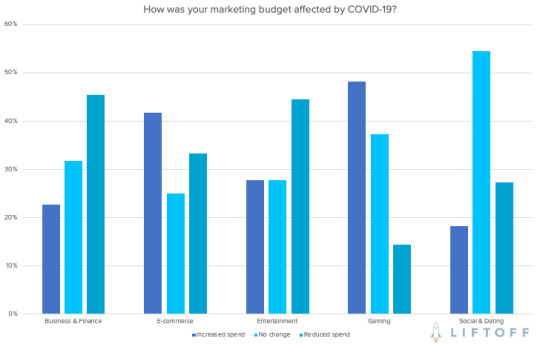
Our final COVID-19 question honed in on budgets. Traditionally, modern crises are followed by a reduction in ad spend as companies save cash. But in our survey, we found the opposite trend. When asked, “How was your marketing budget affected by COVID-19?” only 30% of marketers reporting a decrease in ad spend. In fact, more marketers (35%) experienced an increase of app marketing budget. The largest teams saw the biggest gains (with 50% of respondents in teams of 11+ receiving more budget). Meanwhile, teams with 6-10 saw the most significant reduction, while 57% of solo marketers experienced ‘No change’ in user acquisition spend. By vertical, 48% of gaming app marketers had an increase in campaign budget, while 45% of business & finance marketers reported reduced spend.
What do Mobile Marketers Think About IDFA Changes?

The second survey section covered views of Apple’s upcoming changes to its IDFA. Our analysis started with two simple questions: whether ‘the potential end of the IDFA’ would be good for marketers, and for users. In our findings, 80% of respondents believed that changes to the IDFA will be a net negative for marketers. But for users, the IDFA change was viewed positively, with 60% agreeing with the statement that its deprecation would benefit users.
Responding positively to the user-focused statement, marketers cited that users currently, “have no idea how their data is being used.” As such, the change gives users, “increased personal control over data.” As one respondent pointed out, “the potential end of the IDFA provides more transparency and more data control for the user.”
However, a sizeable minority of marketers do not believe the change is entirely beneficial: “Users will see random, non-personalized ads, making the user experience worse for consumers,” says one respondent. Another believes that “advertisers will have more difficulty tailoring messages” which could cause a more negative impression of advertising overall. But not all respondents took a negative view: “It will be a breath of fresh air when marketers try new things to attract customers to their solutions.”
Another question we asked marketers was: Do you plan to shift more spend to Android? In context, the 2020 Mobile App Trends Report reveals how mobile user acquisition performance on iOS and Android differ, with Google’s platform offering a larger volume of installs while iOS tends to generate more revenue. We wanted to discover whether this data coincided with mobile marketer’s opinions. Here, we’ve broken down results by category to determine where more spend was likely to go.

Business & Finance and Entertainment were the only categories where opinion, positively or negatively, outweighed answers to ‘Not sure’. Business & Finance marketers would likely maintain spend on iOS, while Entertainment app marketers are eyeing a shift towards Android. Overall, 44% of app marketers are unsure of shifting their spend, though more marketers said they would shift towards Android (30%) than would not (26%).
Our survey paints a considerable picture of 2020’s app marketing challenges, and the views of marketers who have to adapt to them. While it’s certain that this year created unique challenges for the ecosystem, it’s impossible to predict how COVID-19 and IDFA changes will impact the industry in both the short and the long term.
For more findings on the trends of 2020, download the 2020 Mobile App Trends Report today. You can also discover more deep insights on our blog—or get regular updates via email by signing up to our newsletter in the sidebar.
The post What did app marketers make of 2020? appeared first on Liftoff.
What did app marketers make of 2020? published first on https://leolarsonblog.tumblr.com/
0 notes
Text
Is SEO Dead? (A Data-Driven Answer)

SEO has been changing drastically over the years.
In 2010, Google made 516 algorithm changes. That number increased to 1,653 in 2016 and to 3,234 in 2018. We don’t have data for the last couple of years, but still, you can bet that the number is continually going up.
With over 9 algorithm changes a day, it’s safe to say that it is no longer easy to manipulate or game Google.
So, is SEO dead?
Well, let’s look at the data and from there I’ll show you what you should do.
Is SEO dead?
Do you know how many searches take place on Google each day?
Roughly 5.6 billion searches per day.
That’s roughly 2 trillion searches each year.
Although that’s a lot of searches, there is also a lot of content being created.
There are roughly a billion blogs on the web.
There are so many blogs that you can find an excessive amount of content on most topics out there.
For example, if you look at the long-tail phrase, “what is digital marketing”, there are only 11,300 global searches a month but a whopping 665,000 pieces of content trying to answer that question.
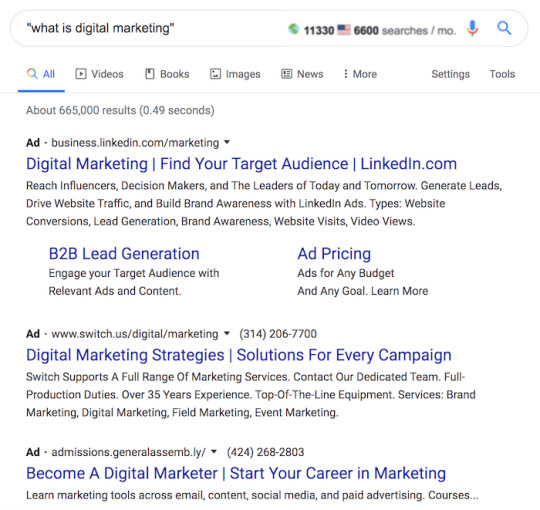
In other words, the supply is much greater than the demand.
You’ll see even more of this for head terms. Just look at the phrase “banana”:
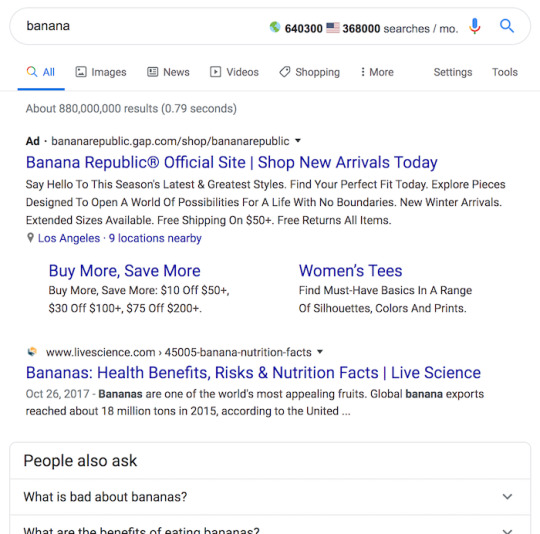
640,300 global searches seem like a high number but there are 880,000,000 million results. Sure, some of those results may not be on the food, banana, but still, that’s a lot of content compared to the search volume.
You can still find search phrases where there is more search volume than content but the trend is continually increasing in which content production is exceeding search demand.
On top of that, Google is turning into an answer engine in which they are answering people’s questions without them having to go to a website.
According to Dejan SEO, they saw CTRs drastically decrease once Google started answering questions. Just look at this weather search query:
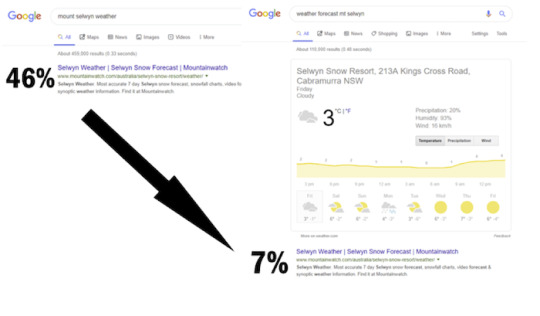
Their clicks from weather-related queries went from 46% all the way down to 7%.
This trend has become so common that the percentage of traffic that Google drives to organic listings (SEO results) has been decreasing over time.
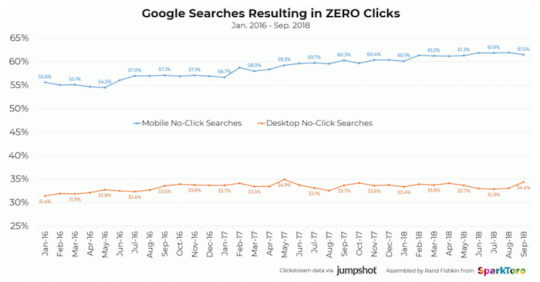
So, does this mean SEO is dead?
It’s actually the opposite.
SEO is not dead
With all of the data, how can that be the case?
First off, all marketing channels become statured over time. It’s just a question of when.
You can say the same thing about Facebook, Instagram, Twitter, and even email marketing.
Heck, just look at the image below. It was the first banner ad on the Internet.

Can you guess what company created that banner ad? It was ATT.
Of the people who saw it, 44% of them clicked on it. Now banner ads generate an average click-through rate of 0.5%.
That’s an enormous drop.
And, as I mentioned above, it’s with all channels. Just look at Instagram engagement rates:
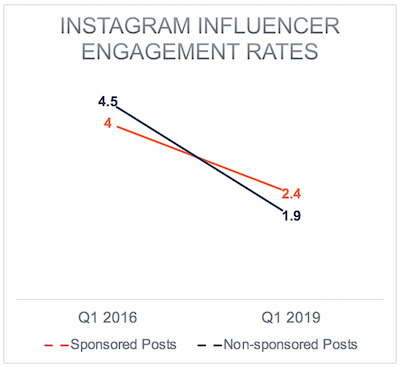
It doesn’t matter if it is a sponsored post or an organic post, the trend on Instagram is that engagement is going down.
That’s why you are seeing people like Gary Vaynerchuk and Grant Cardone promoting their phone numbers all over Instagram.
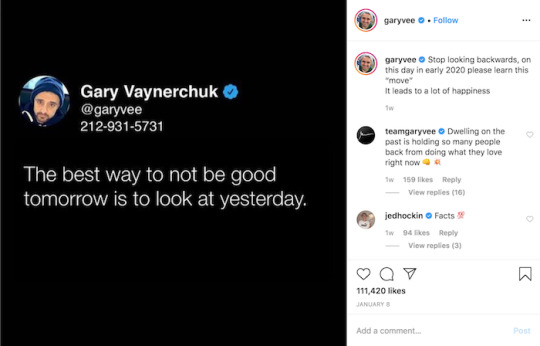
That way they can communicate with their fans directly without having to deal with algorithms or platforms decreasing their engagement.
But even with those decreasing numbers, you are seeing sponsored posts on Instagram surging by 150%.
In other words, people are still spending money because they are seeing an ROI or generating enough value in their eyes.
And the same is happening with digital ad spending.
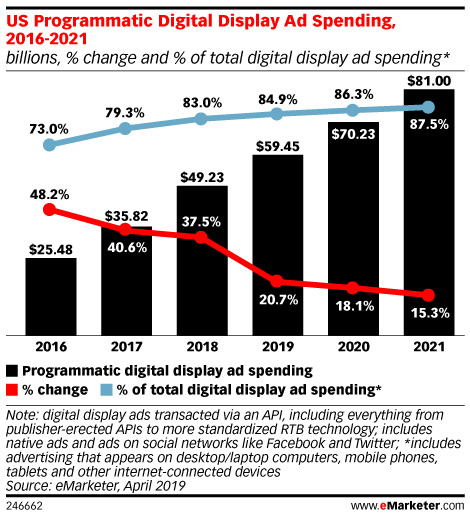
The numbers are on the rise because companies are generating an ROI.
So, how is SEO still not dead?
As I explained above, just because the metrics aren’t going in your favor doesn’t mean that a channel is dead.
Just look at my search traffic on NeilPatel.com.
Not only do I have to deal with Google’s algorithm like you, but my competition includes other marketers who know what I know… yet I am still able to grow my search traffic even with Google’s decreasing CTRs.
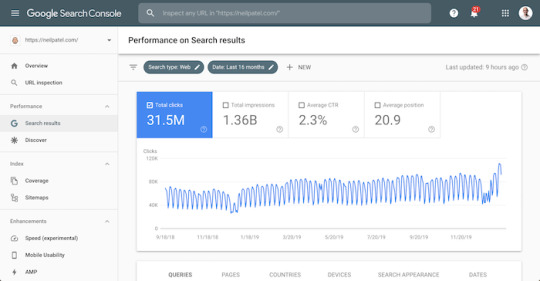
When you look at search as a whole (and I am not only talking about on Bing and Google as people also search on other sites and platforms as well) Google still dominates market share with a whopping 94%.
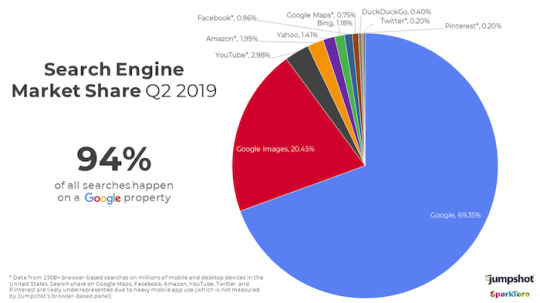
People still use Google and prefer them as their method of search. But what’s changed is how Google is being used.
It used to be where you would use platforms like Instagram for discovery and Google for commerce (purchasing).
The trend has switched over the years in which Instagram is being heavily used for commerce and Google is mainly used as a discovery engine.
Just look at this case study by Olay.
Olay sells products related to skincare. One of their products happens to reduce darkness under your eyes.
So, they used to push heavily on ads that sold their products directly.
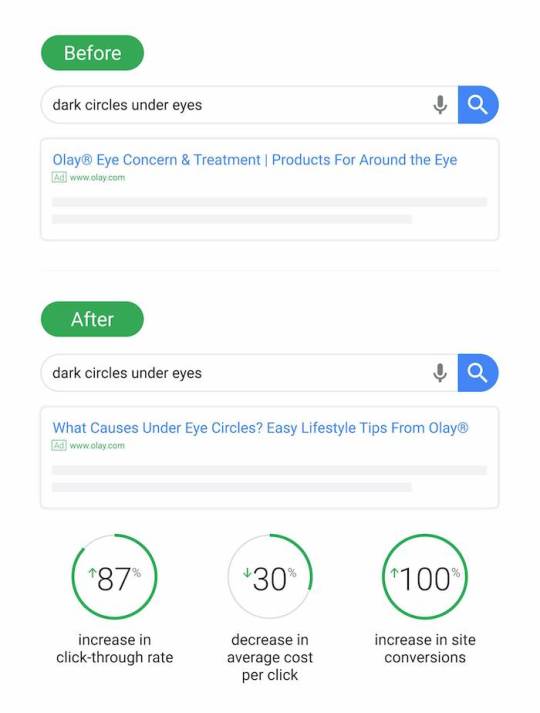
But the moment they changed their ads to focus on education by teaching people how to reduce dark circles under their eyes instead of forcing people to buy their products, their ROI went through the roof.
By sending people to educational-based content first (and then selling through the content), they were able to increase click-throughs by 87%, decrease their cost per click by 30%, and increase conversions by 100%.
This is a prime example of how more people are using Google as a discovery engine first instead of a commerce engine.
SEO isn’t dying it is just changing
Now that you know that Google is shifting to a discovery engine (for both paid and organic listings), there are a few other things you need to know if you want to dominate the organic listings.
1: Google wants to rank sites you want to see
Their algorithm core focus isn’t backlinks or keyword density, or a specific SEO metric… the focus is on the user experience.
If a site has millions of backlinks but users hate it, the site won’t rank well in the long run.
Look at this case study of the “best grilled steaks.”
Rand Fishkin had all of his social followers do the following:
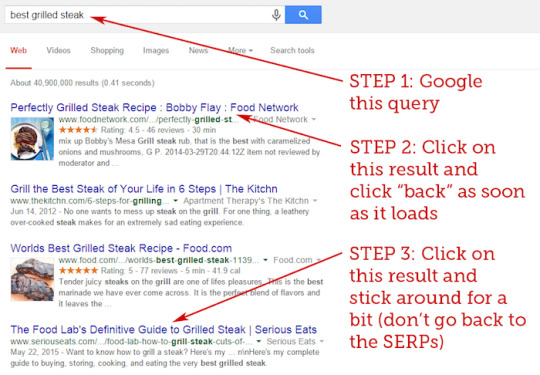
Within 70 minutes, the listing jumped to the top spot.
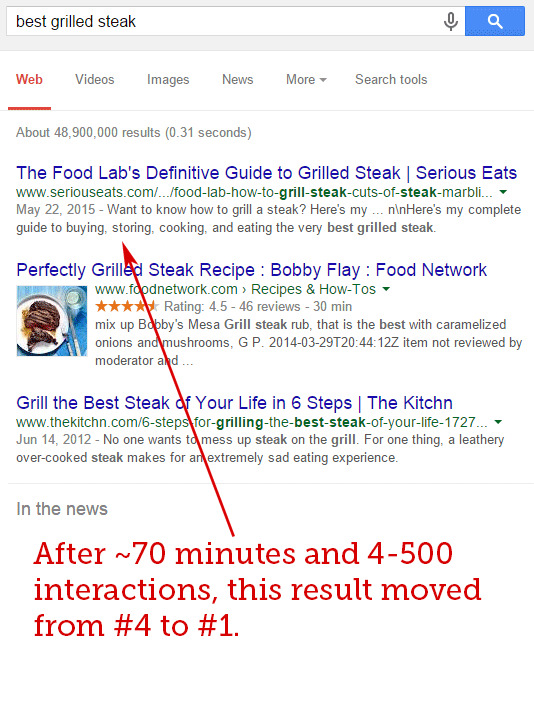
This is what I mean by user signals. You, the end-user, control how Google adjusts rankings.
2. People don’t just use Google. Google gathers data from everywhere.
Google knows you spend hours a day on your mobile device and hours on other sites and applications that aren’t controlled or owned by Google.
So, when they are figuring out what to rank and where to rank it, they aren’t just looking at their own dataset.
They crawl things like social media and use social signals to help them better improve their results.
For example, here is a case study on how Google is using social media for search discovery.
Even if you hate the social web, you need to use it more. Not only can it help with your site’s indexing but it can also help with brand building, which indirectly will help boost your rankings as well.
Here are some articles to follow to help boost your social media presence:
How to Gain 1,260 Instagram Followers per Week
16 Powerful Facebook Marketing Tips That Actually Work
The Complete Guide to Using Twitter to Grow Your Business
9 LinkedIn Marketing Tips
How to Hack YouTube
The Ultimate Guide to Pinterest Marketing
4 Principles of Successful Snapchat Marketing
3. Google loves brands
If you don’t believe me, just look at these quotes from Google’s ex-CEO and ex-head of webspam.

They both believe in brands.
As your brand grows, you’ll find that your rankings will climb as well.
You saw my search traffic stats earlier in the post, but here’s a breakdown of how many people found my site by searching for my name in the last 7 days.

And that number doesn’t even include the misspellings. You would be shocked at how many people spell my name as “niel” instead of “neil.”
Google loves brands. Heck, when you type in “men’s running shoes,” they even have Nike, Adidas, and Asics there.

Branded search volume is more correlated with rankings than links or domain authority.
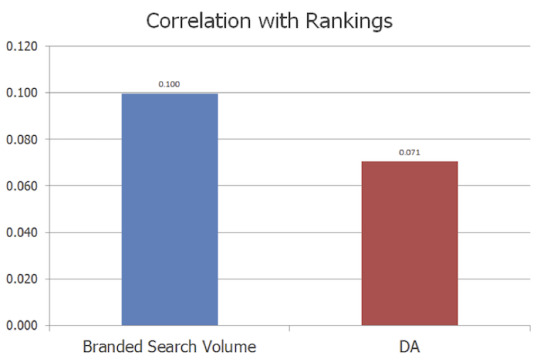
If you want to build a brand, focus on the social media articles I linked to above and follow the brand building articles below:
How to Dominate Google
How to Increase Rankings Through Brand Mentions
How to Use SEO to Build Your Brand
The Future of SEO
If you are still struggling to build a brand, talk to one of my team members about our Digital PR.
4. Focus on a niche
Do you remember the old-school site About.com?
Over time, About.com tanked in terms of their Google rankings and the business was dying. There were a few reasons why:
The site didn’t focus on a single niche… it was about everything
The content was mediocre. They didn’t go in-depth but instead just kept things surface level.
They had too much content that no one cared to read.
They decided to rebrand as Dotdash and start niching down. So they took the content on About.com and split it into six specific vertical sites.
When doing this they found that a lot of the content didn’t fit into those 6 verticals or wasn’t up to their new quality standard. This caused them them delete roughly 900,000 articles.
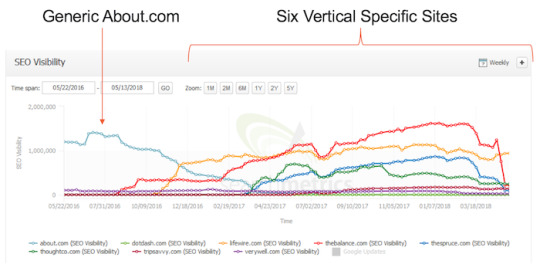
From the data, you can see that they got much more traffic by splitting up their content into niched-down sites.
It was so successful that they took one of their new vertical sites and broke it down further into three niche sites. Here were the results:

This helped them grow their revenue by 140%.
If you want to do well in today’s world of SEO, focus on one niche. Google prefers topic-specific sites because that’s what you and everyone else loves.
Just think of it this way… would you rather read medical advice from About.com or WebMD?
WebMD of course.
Another thing they did
5. Future is personalization
Have you noticed that when you search on Google the results you see are different than the results of your friends?
It’s because Google is trying to personalize the results to you.
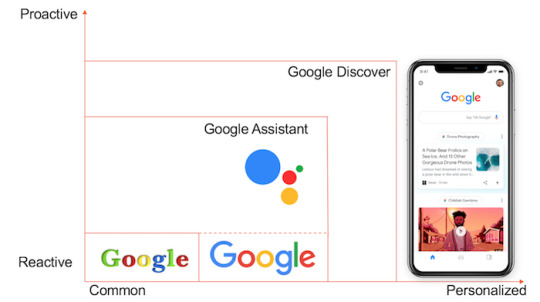
Not just on Google search but anywhere you use a Google device… from a smartphone to Google Home to even their autonomous cars.
With all of the data they are gathering, they are better suited to understand your preferences and then modify the results to that.
Just think of it this way: Every time you visit a place and you are carrying your mobile phone (especially if it is an Android device), Google may be able to potentially use that information to tailor results to you.
With your website, don’t try and show everyone the same message. If you personalize your experience to each and every user, you will be able to rank better in the long run as it will improve your user metrics.
A good example of this is on my blog.
Right when you land there, I let you pick the type of content you want to see and then the page adapts to your interest.
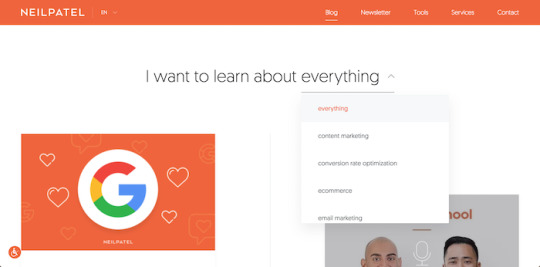
It’s actually the most clicked area on the blog, believe it or not.
Conclusion
SEO is not dead, it’s just changing.
Sure, click-through rates are going down and Google keeps adjusting its algorithm but that’s to be expected.
Google has made it so you can easily target your ideal customer through SEO or paid ads.
It used to be much more difficult before they came along. That’s why they are able to generate over 100 billion dollars a year in advertising revenue.
Don’t worry about things that aren’t in your control. Instead, start adapting or your traffic and business will be dead.
What do you think about the changing SEO landscape?
The post Is SEO Dead? (A Data-Driven Answer) appeared first on Neil Patel.
Is SEO Dead? (A Data-Driven Answer) Publicado primeiro em https://neilpatel.com
0 notes
Text
Is SEO Dead? (A Data-Driven Answer)

SEO has been changing drastically over the years.
In 2010, Google made 516 algorithm changes. That number increased to 1,653 in 2016 and to 3,234 in 2018. We don’t have data for the last couple of years, but still, you can bet that the number is continually going up.
With over 9 algorithm changes a day, it’s safe to say that it is no longer easy to manipulate or game Google.
So, is SEO dead?
Well, let’s look at the data and from there I’ll show you what you should do.
Is SEO dead?
Do you know how many searches take place on Google each day?
Roughly 5.6 billion searches per day.
That’s roughly 2 trillion searches each year.
Although that’s a lot of searches, there is also a lot of content being created.
There are roughly a billion blogs on the web.
There are so many blogs that you can find an excessive amount of content on most topics out there.
For example, if you look at the long-tail phrase, “what is digital marketing”, there are only 11,300 global searches a month but a whopping 665,000 pieces of content trying to answer that question.
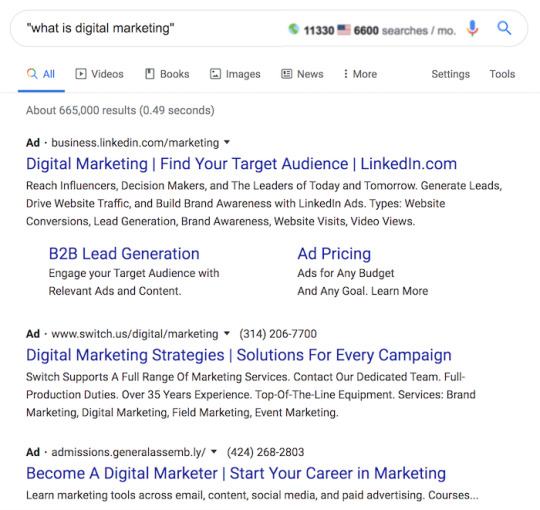
In other words, the supply is much greater than the demand.
You’ll see even more of this for head terms. Just look at the phrase “banana”:
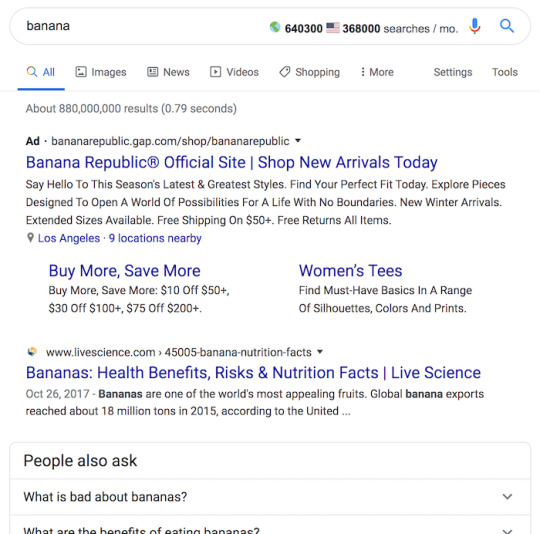
640,300 global searches seem like a high number but there are 880,000,000 million results. Sure, some of those results may not be on the food, banana, but still, that’s a lot of content compared to the search volume.
You can still find search phrases where there is more search volume than content but the trend is continually increasing in which content production is exceeding search demand.
On top of that, Google is turning into an answer engine in which they are answering people’s questions without them having to go to a website.
According to Dejan SEO, they saw CTRs drastically decrease once Google started answering questions. Just look at this weather search query:
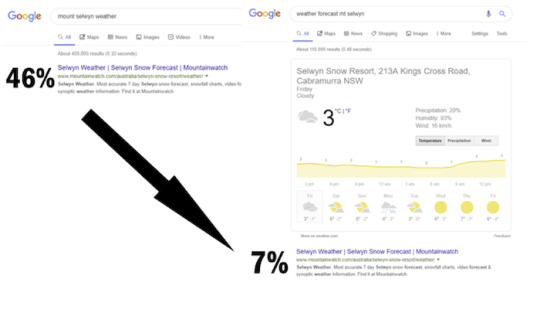
Their clicks from weather-related queries went from 46% all the way down to 7%.
This trend has become so common that the percentage of traffic that Google drives to organic listings (SEO results) has been decreasing over time.
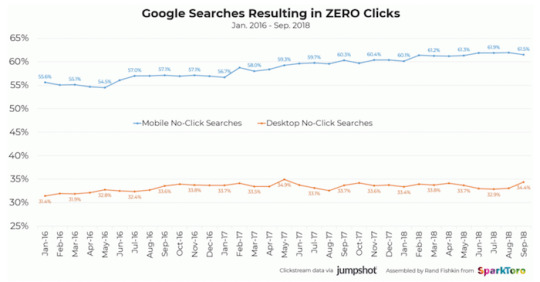
So, does this mean SEO is dead?
It’s actually the opposite.
SEO is not dead
With all of the data, how can that be the case?
First off, all marketing channels become statured over time. It’s just a question of when.
You can say the same thing about Facebook, Instagram, Twitter, and even email marketing.
Heck, just look at the image below. It was the first banner ad on the Internet.

Can you guess what company created that banner ad? It was ATT.
Of the people who saw it, 44% of them clicked on it. Now banner ads generate an average click-through rate of 0.5%.
That’s an enormous drop.
And, as I mentioned above, it’s with all channels. Just look at Instagram engagement rates:
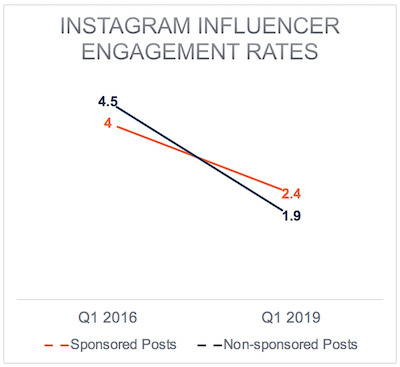
It doesn’t matter if it is a sponsored post or an organic post, the trend on Instagram is that engagement is going down.
That’s why you are seeing people like Gary Vaynerchuk and Grant Cardone promoting their phone numbers all over Instagram.
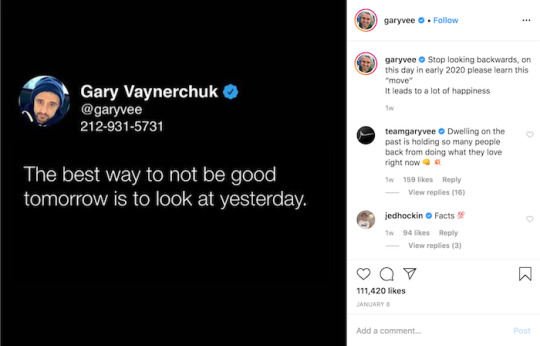
That way they can communicate with their fans directly without having to deal with algorithms or platforms decreasing their engagement.
But even with those decreasing numbers, you are seeing sponsored posts on Instagram surging by 150%.
In other words, people are still spending money because they are seeing an ROI or generating enough value in their eyes.
And the same is happening with digital ad spending.
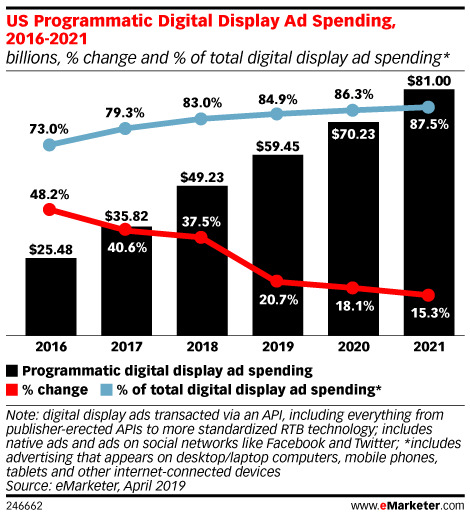
The numbers are on the rise because companies are generating an ROI.
So, how is SEO still not dead?
As I explained above, just because the metrics aren’t going in your favor doesn’t mean that a channel is dead.
Just look at my search traffic on NeilPatel.com.
Not only do I have to deal with Google’s algorithm like you, but my competition includes other marketers who know what I know… yet I am still able to grow my search traffic even with Google’s decreasing CTRs.
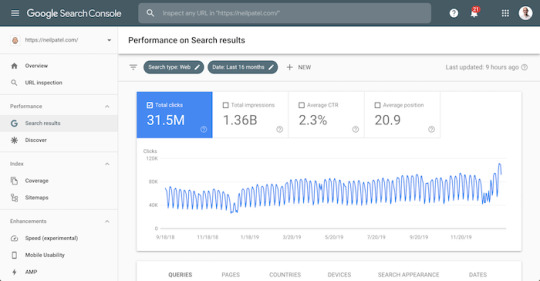
When you look at search as a whole (and I am not only talking about on Bing and Google as people also search on other sites and platforms as well) Google still dominates market share with a whopping 94%.
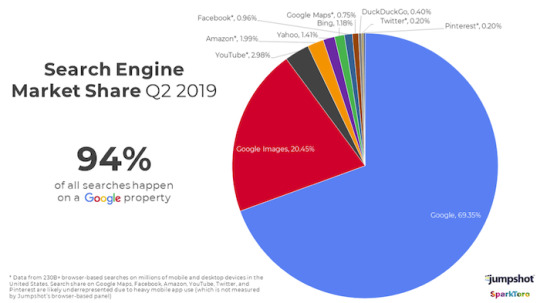
People still use Google and prefer them as their method of search. But what’s changed is how Google is being used.
It used to be where you would use platforms like Instagram for discovery and Google for commerce (purchasing).
The trend has switched over the years in which Instagram is being heavily used for commerce and Google is mainly used as a discovery engine.
Just look at this case study by Olay.
Olay sells products related to skincare. One of their products happens to reduce darkness under your eyes.
So, they used to push heavily on ads that sold their products directly.
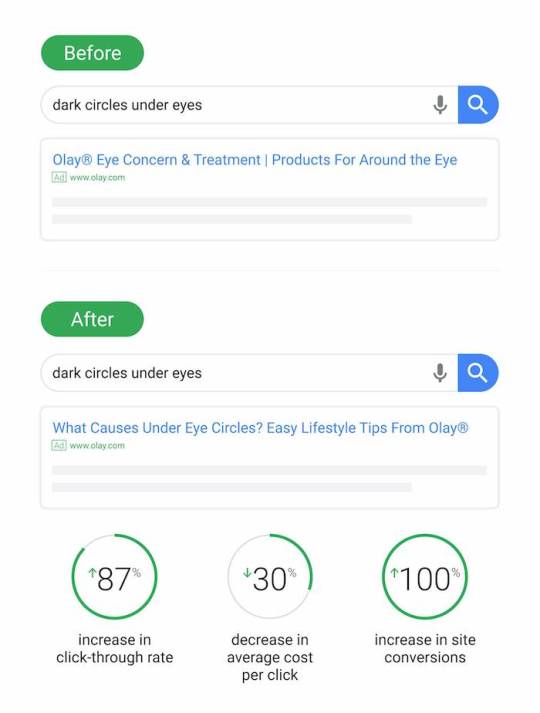
But the moment they changed their ads to focus on education by teaching people how to reduce dark circles under their eyes instead of forcing people to buy their products, their ROI went through the roof.
By sending people to educational-based content first (and then selling through the content), they were able to increase click-throughs by 87%, decrease their cost per click by 30%, and increase conversions by 100%.
This is a prime example of how more people are using Google as a discovery engine first instead of a commerce engine.
SEO isn’t dying it is just changing
Now that you know that Google is shifting to a discovery engine (for both paid and organic listings), there are a few other things you need to know if you want to dominate the organic listings.
1: Google wants to rank sites you want to see
Their algorithm core focus isn’t backlinks or keyword density, or a specific SEO metric… the focus is on the user experience.
If a site has millions of backlinks but users hate it, the site won’t rank well in the long run.
Look at this case study of the “best grilled steaks.”
Rand Fishkin had all of his social followers do the following:
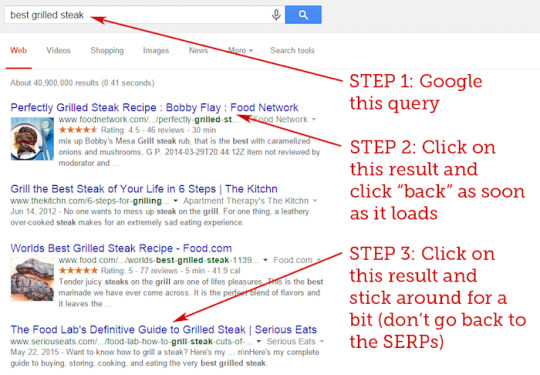
Within 70 minutes, the listing jumped to the top spot.
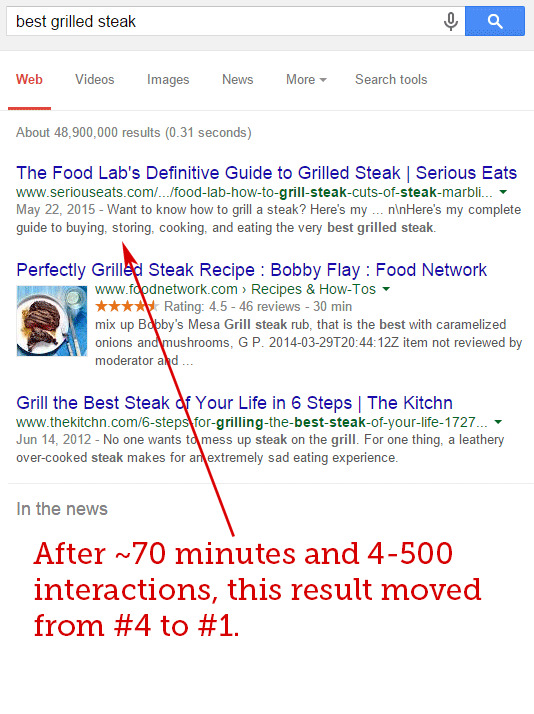
This is what I mean by user signals. You, the end-user, control how Google adjusts rankings.
2. People don’t just use Google. Google gathers data from everywhere.
Google knows you spend hours a day on your mobile device and hours on other sites and applications that aren’t controlled or owned by Google.
So, when they are figuring out what to rank and where to rank it, they aren’t just looking at their own dataset.
They crawl things like social media and use social signals to help them better improve their results.
For example, here is a case study on how Google is using social media for search discovery.
Even if you hate the social web, you need to use it more. Not only can it help with your site’s indexing but it can also help with brand building, which indirectly will help boost your rankings as well.
Here are some articles to follow to help boost your social media presence:
How to Gain 1,260 Instagram Followers per Week
16 Powerful Facebook Marketing Tips That Actually Work
The Complete Guide to Using Twitter to Grow Your Business
9 LinkedIn Marketing Tips
How to Hack YouTube
The Ultimate Guide to Pinterest Marketing
4 Principles of Successful Snapchat Marketing
3. Google loves brands
If you don’t believe me, just look at these quotes from Google’s ex-CEO and ex-head of webspam.

They both believe in brands.
As your brand grows, you’ll find that your rankings will climb as well.
You saw my search traffic stats earlier in the post, but here’s a breakdown of how many people found my site by searching for my name in the last 7 days.
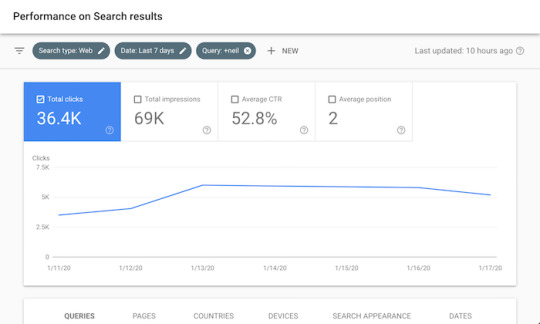
And that number doesn’t even include the misspellings. You would be shocked at how many people spell my name as “niel” instead of “neil.”
Google loves brands. Heck, when you type in “men’s running shoes,” they even have Nike, Adidas, and Asics there.

Branded search volume is more correlated with rankings than links or domain authority.
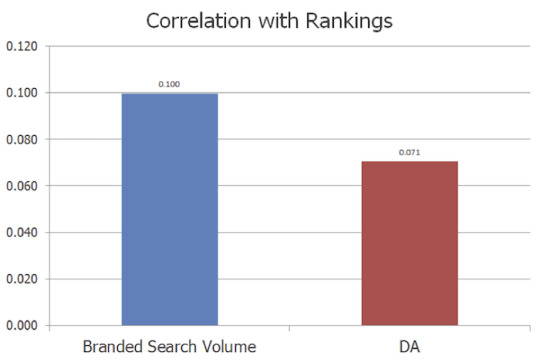
If you want to build a brand, focus on the social media articles I linked to above and follow the brand building articles below:
How to Dominate Google
How to Increase Rankings Through Brand Mentions
How to Use SEO to Build Your Brand
The Future of SEO
If you are still struggling to build a brand, talk to one of my team members about our Digital PR.
4. Focus on a niche
Do you remember the old-school site About.com?
Over time, About.com tanked in terms of their Google rankings and the business was dying. There were a few reasons why:
The site didn’t focus on a single niche… it was about everything
The content was mediocre. They didn’t go in-depth but instead just kept things surface level.
They had too much content that no one cared to read.
They decided to rebrand as Dotdash and start niching down. So they took the content on About.com and split it into six specific vertical sites.
When doing this they found that a lot of the content didn’t fit into those 6 verticals or wasn’t up to their new quality standard. This caused them them delete roughly 900,000 articles.
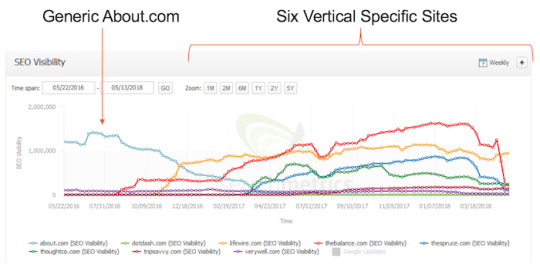
From the data, you can see that they got much more traffic by splitting up their content into niched-down sites.
It was so successful that they took one of their new vertical sites and broke it down further into three niche sites. Here were the results:

This helped them grow their revenue by 140%.
If you want to do well in today’s world of SEO, focus on one niche. Google prefers topic-specific sites because that’s what you and everyone else loves.
Just think of it this way… would you rather read medical advice from About.com or WebMD?
WebMD of course.
Another thing they did
5. Future is personalization
Have you noticed that when you search on Google the results you see are different than the results of your friends?
It’s because Google is trying to personalize the results to you.

Not just on Google search but anywhere you use a Google device… from a smartphone to Google Home to even their autonomous cars.
With all of the data they are gathering, they are better suited to understand your preferences and then modify the results to that.
Just think of it this way: Every time you visit a place and you are carrying your mobile phone (especially if it is an Android device), Google may be able to potentially use that information to tailor results to you.
With your website, don’t try and show everyone the same message. If you personalize your experience to each and every user, you will be able to rank better in the long run as it will improve your user metrics.
A good example of this is on my blog.
Right when you land there, I let you pick the type of content you want to see and then the page adapts to your interest.
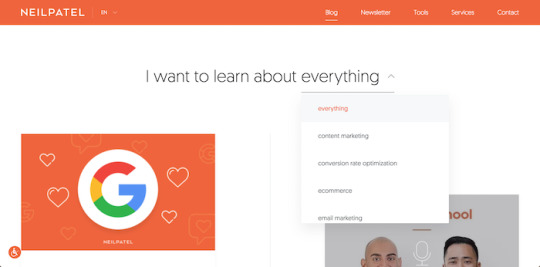
It’s actually the most clicked area on the blog, believe it or not.
Conclusion
SEO is not dead, it’s just changing.
Sure, click-through rates are going down and Google keeps adjusting its algorithm but that’s to be expected.
Google has made it so you can easily target your ideal customer through SEO or paid ads.
It used to be much more difficult before they came along. That’s why they are able to generate over 100 billion dollars a year in advertising revenue.
Don’t worry about things that aren’t in your control. Instead, start adapting or your traffic and business will be dead.
What do you think about the changing SEO landscape?
The post Is SEO Dead? (A Data-Driven Answer) appeared first on Neil Patel.
Original content source: https://neilpatel.com/blog/seo-dead/ via https://neilpatel.com
The original post, Is SEO Dead? (A Data-Driven Answer), has been shared from https://imtrainingparadise.wordpress.com/2020/01/21/is-seo-dead-a-data-driven-answer/ via https://imtrainingparadise.wordpress.com
0 notes
Text
Is SEO Dead? (A Data-Driven Answer)

SEO has been changing drastically over the years.
In 2010, Google made 516 algorithm changes. That number increased to 1,653 in 2016 and to 3,234 in 2018. We don’t have data for the last couple of years, but still, you can bet that the number is continually going up.
With over 9 algorithm changes a day, it’s safe to say that it is no longer easy to manipulate or game Google.
So, is SEO dead?
Well, let’s look at the data and from there I’ll show you what you should do.
Is SEO dead?
Do you know how many searches take place on Google each day?
Roughly 5.6 billion searches per day.
That’s roughly 2 trillion searches each year.
Although that’s a lot of searches, there is also a lot of content being created.
There are roughly a billion blogs on the web.
There are so many blogs that you can find an excessive amount of content on most topics out there.
For example, if you look at the long-tail phrase, “what is digital marketing”, there are only 11,300 global searches a month but a whopping 665,000 pieces of content trying to answer that question.
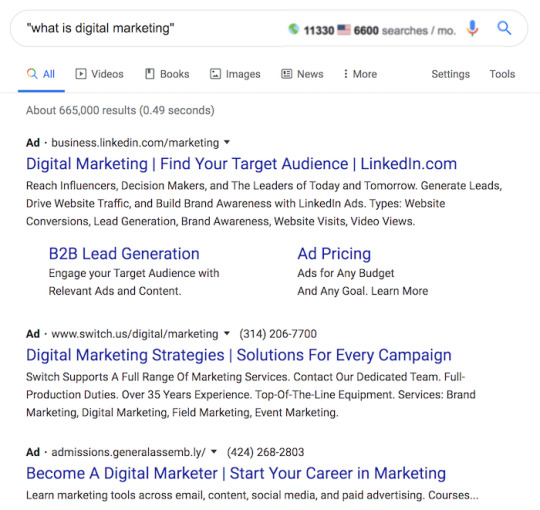
In other words, the supply is much greater than the demand.
You’ll see even more of this for head terms. Just look at the phrase “banana”:
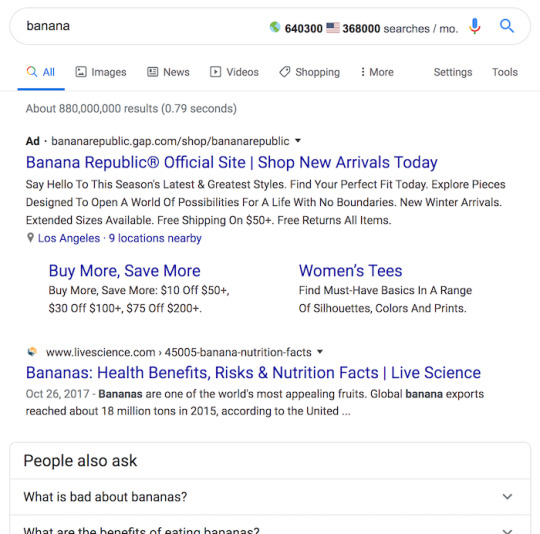
640,300 global searches seem like a high number but there are 880,000,000 million results. Sure, some of those results may not be on the food, banana, but still, that’s a lot of content compared to the search volume.
You can still find search phrases where there is more search volume than content but the trend is continually increasing in which content production is exceeding search demand.
On top of that, Google is turning into an answer engine in which they are answering people’s questions without them having to go to a website.
According to Dejan SEO, they saw CTRs drastically decrease once Google started answering questions. Just look at this weather search query:
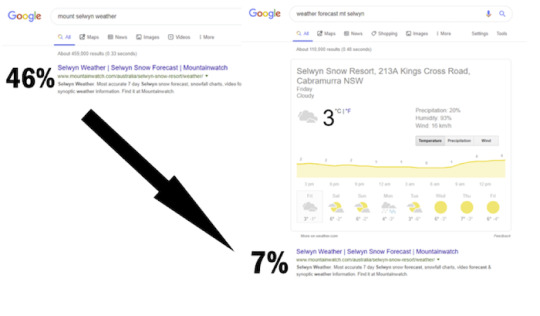
Their clicks from weather-related queries went from 46% all the way down to 7%.
This trend has become so common that the percentage of traffic that Google drives to organic listings (SEO results) has been decreasing over time.
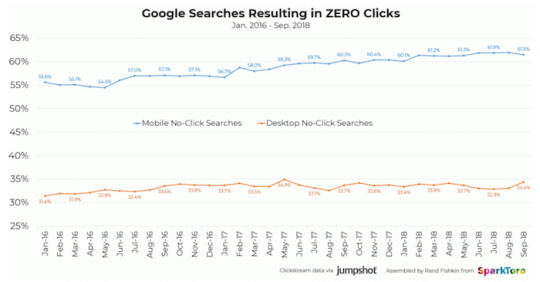
So, does this mean SEO is dead?
It’s actually the opposite.
SEO is not dead
With all of the data, how can that be the case?
First off, all marketing channels become statured over time. It’s just a question of when.
You can say the same thing about Facebook, Instagram, Twitter, and even email marketing.
Heck, just look at the image below. It was the first banner ad on the Internet.

Can you guess what company created that banner ad? It was ATT.
Of the people who saw it, 44% of them clicked on it. Now banner ads generate an average click-through rate of 0.5%.
That’s an enormous drop.
And, as I mentioned above, it’s with all channels. Just look at Instagram engagement rates:
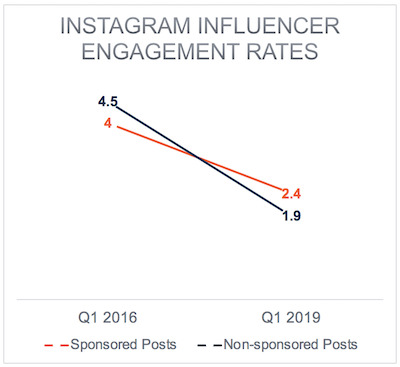
It doesn’t matter if it is a sponsored post or an organic post, the trend on Instagram is that engagement is going down.
That’s why you are seeing people like Gary Vaynerchuk and Grant Cardone promoting their phone numbers all over Instagram.
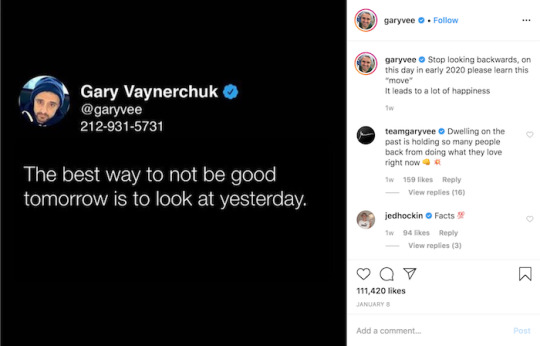
That way they can communicate with their fans directly without having to deal with algorithms or platforms decreasing their engagement.
But even with those decreasing numbers, you are seeing sponsored posts on Instagram surging by 150%.
In other words, people are still spending money because they are seeing an ROI or generating enough value in their eyes.
And the same is happening with digital ad spending.
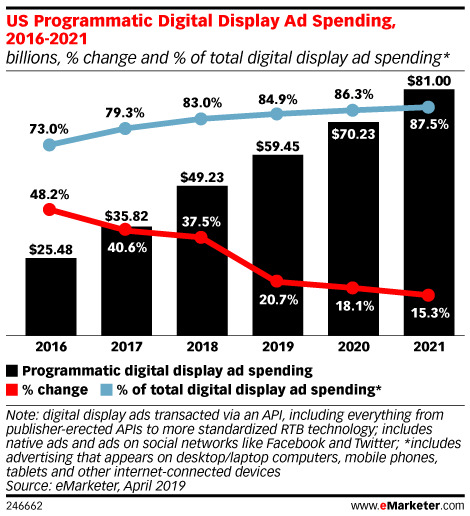
The numbers are on the rise because companies are generating an ROI.
So, how is SEO still not dead?
As I explained above, just because the metrics aren’t going in your favor doesn’t mean that a channel is dead.
Just look at my search traffic on NeilPatel.com.
Not only do I have to deal with Google’s algorithm like you, but my competition includes other marketers who know what I know… yet I am still able to grow my search traffic even with Google’s decreasing CTRs.
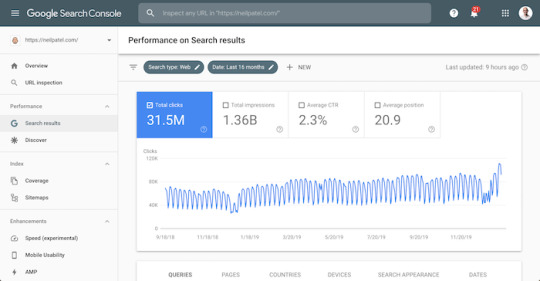
When you look at search as a whole (and I am not only talking about on Bing and Google as people also search on other sites and platforms as well) Google still dominates market share with a whopping 94%.
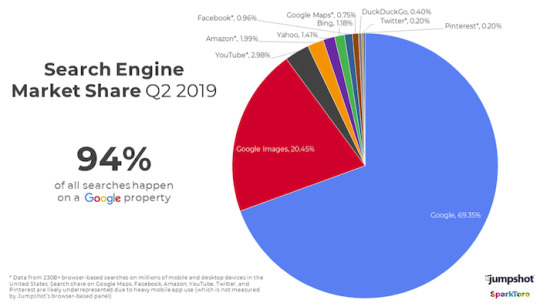
People still use Google and prefer them as their method of search. But what’s changed is how Google is being used.
It used to be where you would use platforms like Instagram for discovery and Google for commerce (purchasing).
The trend has switched over the years in which Instagram is being heavily used for commerce and Google is mainly used as a discovery engine.
Just look at this case study by Olay.
Olay sells products related to skincare. One of their products happens to reduce darkness under your eyes.
So, they used to push heavily on ads that sold their products directly.
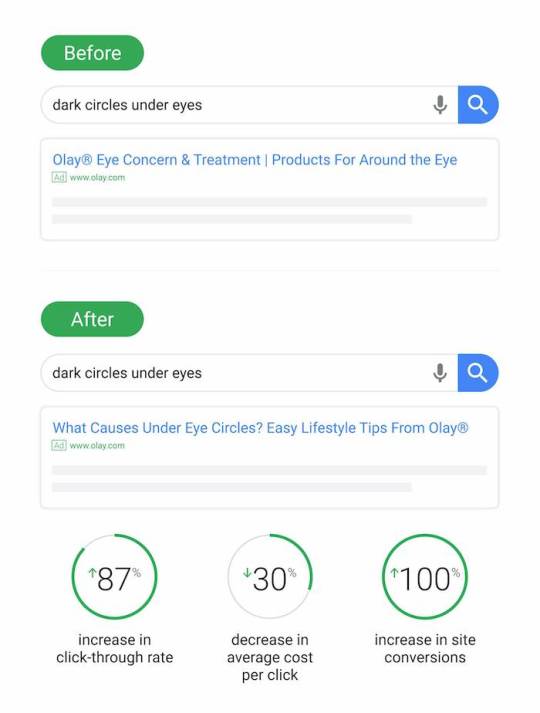
But the moment they changed their ads to focus on education by teaching people how to reduce dark circles under their eyes instead of forcing people to buy their products, their ROI went through the roof.
By sending people to educational-based content first (and then selling through the content), they were able to increase click-throughs by 87%, decrease their cost per click by 30%, and increase conversions by 100%.
This is a prime example of how more people are using Google as a discovery engine first instead of a commerce engine.
SEO isn’t dying it is just changing
Now that you know that Google is shifting to a discovery engine (for both paid and organic listings), there are a few other things you need to know if you want to dominate the organic listings.
1: Google wants to rank sites you want to see
Their algorithm core focus isn’t backlinks or keyword density, or a specific SEO metric… the focus is on the user experience.
If a site has millions of backlinks but users hate it, the site won’t rank well in the long run.
Look at this case study of the “best grilled steaks.”
Rand Fishkin had all of his social followers do the following:
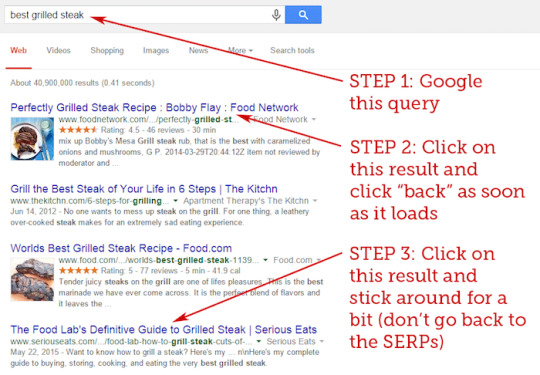
Within 70 minutes, the listing jumped to the top spot.

This is what I mean by user signals. You, the end-user, control how Google adjusts rankings.
2. People don’t just use Google. Google gathers data from everywhere.
Google knows you spend hours a day on your mobile device and hours on other sites and applications that aren’t controlled or owned by Google.
So, when they are figuring out what to rank and where to rank it, they aren’t just looking at their own dataset.
They crawl things like social media and use social signals to help them better improve their results.
For example, here is a case study on how Google is using social media for search discovery.
Even if you hate the social web, you need to use it more. Not only can it help with your site’s indexing but it can also help with brand building, which indirectly will help boost your rankings as well.
Here are some articles to follow to help boost your social media presence:
How to Gain 1,260 Instagram Followers per Week
16 Powerful Facebook Marketing Tips That Actually Work
The Complete Guide to Using Twitter to Grow Your Business
9 LinkedIn Marketing Tips
How to Hack YouTube
The Ultimate Guide to Pinterest Marketing
4 Principles of Successful Snapchat Marketing
3. Google loves brands
If you don’t believe me, just look at these quotes from Google’s ex-CEO and ex-head of webspam.

They both believe in brands.
As your brand grows, you’ll find that your rankings will climb as well.
You saw my search traffic stats earlier in the post, but here’s a breakdown of how many people found my site by searching for my name in the last 7 days.
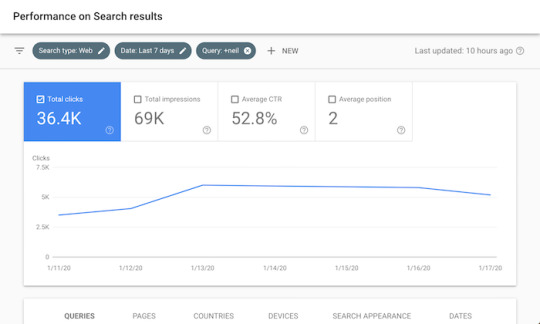
And that number doesn’t even include the misspellings. You would be shocked at how many people spell my name as “niel” instead of “neil.”
Google loves brands. Heck, when you type in “men’s running shoes,” they even have Nike, Adidas, and Asics there.

Branded search volume is more correlated with rankings than links or domain authority.
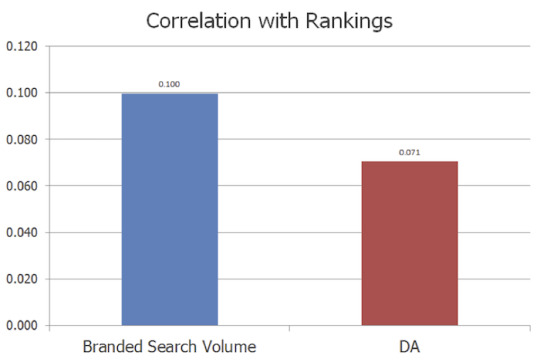
If you want to build a brand, focus on the social media articles I linked to above and follow the brand building articles below:
How to Dominate Google
How to Increase Rankings Through Brand Mentions
How to Use SEO to Build Your Brand
The Future of SEO
If you are still struggling to build a brand, talk to one of my team members about our Digital PR.
4. Focus on a niche
Do you remember the old-school site About.com?
Over time, About.com tanked in terms of their Google rankings and the business was dying. There were a few reasons why:
The site didn’t focus on a single niche… it was about everything
The content was mediocre. They didn’t go in-depth but instead just kept things surface level.
They had too much content that no one cared to read.
They decided to rebrand as Dotdash and start niching down. So they took the content on About.com and split it into six specific vertical sites.
When doing this they found that a lot of the content didn’t fit into those 6 verticals or wasn’t up to their new quality standard. This caused them them delete roughly 900,000 articles.
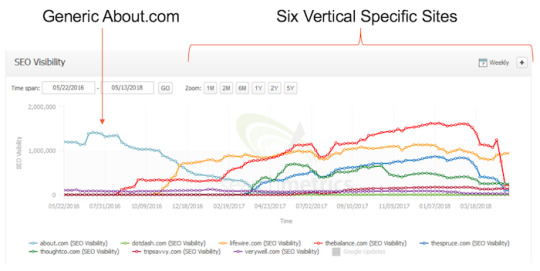
From the data, you can see that they got much more traffic by splitting up their content into niched-down sites.
It was so successful that they took one of their new vertical sites and broke it down further into three niche sites. Here were the results:

This helped them grow their revenue by 140%.
If you want to do well in today’s world of SEO, focus on one niche. Google prefers topic-specific sites because that’s what you and everyone else loves.
Just think of it this way… would you rather read medical advice from About.com or WebMD?
WebMD of course.
Another thing they did
5. Future is personalization
Have you noticed that when you search on Google the results you see are different than the results of your friends?
It’s because Google is trying to personalize the results to you.
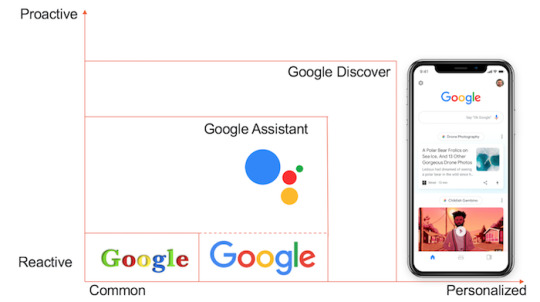
Not just on Google search but anywhere you use a Google device… from a smartphone to Google Home to even their autonomous cars.
With all of the data they are gathering, they are better suited to understand your preferences and then modify the results to that.
Just think of it this way: Every time you visit a place and you are carrying your mobile phone (especially if it is an Android device), Google may be able to potentially use that information to tailor results to you.
With your website, don’t try and show everyone the same message. If you personalize your experience to each and every user, you will be able to rank better in the long run as it will improve your user metrics.
A good example of this is on my blog.
Right when you land there, I let you pick the type of content you want to see and then the page adapts to your interest.
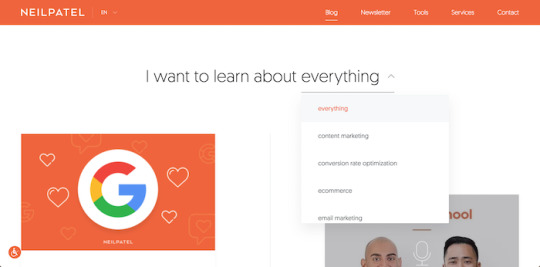
It’s actually the most clicked area on the blog, believe it or not.
Conclusion
SEO is not dead, it’s just changing.
Sure, click-through rates are going down and Google keeps adjusting its algorithm but that’s to be expected.
Google has made it so you can easily target your ideal customer through SEO or paid ads.
It used to be much more difficult before they came along. That’s why they are able to generate over 100 billion dollars a year in advertising revenue.
Don’t worry about things that aren’t in your control. Instead, start adapting or your traffic and business will be dead.
What do you think about the changing SEO landscape?
The post Is SEO Dead? (A Data-Driven Answer) appeared first on Neil Patel.
Original content source: https://ift.tt/2qdL8ni via https://neilpatel.com The post, Is SEO Dead? (A Data-Driven Answer), has been shared from https://ift.tt/2G8TKBz via https://ift.tt/2r0Go64
0 notes
Text
Top 5 Best and Worst Breath of the Wild Shrines
Breath of the Wild is, without any doubts, the Zelda game that takes the longest to fully complete, and part of the reason for this are the 120 shrines spread across the map. Most of those shrines offer different challenges where many different gameplay techniques must be used in order to reach the end, and I say most because this also includes the blessing shrines, which are pretty much free but are harder to get to or require a shrine quest, which I’ll talk about in another list. After having completed Breath of the Wild, I have enough experience to make a final list of the Top 5 Best and Worst shrines in the game, based on originality, length and design, so here it starts!
#5 (Best) - Synched Swing || Mogg Latan Shrine

One thing that I really appreciate of puzzles is when they allow the players to solve it in different ways, and this shrine is the one that does it in the best way possible. It starts with two small jumps that you can perform with ease, but the next one is too far away. Since it’s a swing, you can just use Magnesis or Stasis to make it move back and forth. After using two arrows to lower a gate, here comes the most interesting part of the shrine: the spikey balls. I initially solved this part by making each ball swing for a bit, then using stasis to move forward, but most people seem to prefer using Magnesis to stick it to the ceiling. Finally, there are a few metal platforms that you need to move in order to create a staircase, but has a golden rupee hiding below, so beating this shrine, which is among the most challenging ones of the game in a good way, not only gives you satisfaction, but also quite a bit of money.
#5 (Worst) - Tempered Power || Mirro Shaz Shrine

Welcome to the shrine that was meant to be hated by nature. At first, it doesn’t look really bad. You just hit a ball to a hole in a golf-like manner, solve a very short puzzle and there’s the end. But the real challenge comes when you skip the goal and advance further. Now welcome to the ultimate, weapon-breaking and rage-inducing challenge. Almost perfect precission is required to hit the ball in the perfect angle and strength. Once you figure out moving the ball a bit backwards makes it easier, you get your well-deserved price. Were you expecting a diamond, a golden rupee or even a shooting star? Nope, you get a Great Ancient Core, which is rare, but easily obtainable compared to other items.
#4 (Best) - Fateful Stars || Keo Ruug Shrine

Before you light your torches or call the FBI, let me clear thing up. I liked this shrine unlike most of the Internet, but that’s because y’all probably gave up way too early on figuring it out, when the answer was right in front of you all this time. You just need to watch the four constellations drawn in the walls in front of each row of holes, and count how many of each kinds are drawn in the big panel at the back of the room. Takes a while to figure out, but feels good to do. As a former Layton player, this shrine really reminded me of a puzzle something you’d find there. Also there’s a second one if you want to get a knight’s claymore, if you didn’t get fed up before that is.
#4 (Worst) - Two Bombs || Sho Dantu Shrine
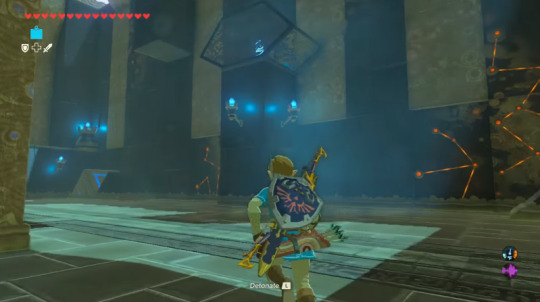
And after putting a heavily hated shrine among the best ones, here comes a fan-favoruties among my most hated ones! Call it biased, but I’m putting this one here because I thought I was doing the final room the wrong way the entire time. The actual solution is making both bombs fly together, moving to one of the elevators, detonating the square one when it lands in the middle, and finally detonating the other one when it flies over the switch. Seems easy, but my problem was the sphere bomb. I could never hit the switch properly, mostly because of the small window of time you’ve got and because the camera wasn’t behaving really nicely, and after wasting a few minutes trying alternate solutions, I finally did it by doing the first thing that came to my mind. Clever puzzle, I admit, but a little bit sketchy.
#3 (Best) - Wind Guide || Kah Okeo Shrine

You better bring a Korok Leaf to this one, because you’re definitely going to need it. As the name implies, wind is the main element you need to master in this shrine by riding platforms or moving floating exploding barrels to the correct spots. Despite the fact that wind works in the opposite way on this shrine, it’s still a very clever mechanic that isn’t used anywhere else in Normal mode. Also, all of the barrel sections can be skipped if you have explosive bombs, but it’s up to you whether you want to solve it the fast way or not. The last area seems like a mess of platforms, barrels, wind currents and elevators, but it’s pretty fun to explore and find all of the hidden chests, one of which contains the key needed to get to the end. Also, there are a few cute small guardians for you to kill, in case this shrine seemed to unexciting to you.
#3 (Worst) - Impeccable Timing || Shoda Sah Shrine

Just imagine all of the potential this one could have had, but Nintendo missed. You need to put balls into cannons and release them at the correct time so they land in the hole, which is big and not easy to miss. One of the puzzles contains the key, and the other contains five ice arrows, a price that matches the level of excitement of this shrine. To make it even easier, you can stop the vertical moving platforms using stasis. If you happen to miss five hits, you need to use Cryonis to slowly recover the balls, but I don’t think that’ll ever happen considering how ridiculously easy this one is. I’d have loved this one if it was longer and more challenging.
#2 (Best) - Blue Flame || Kaam Ya’Tak Shrine

The fanbase has mixed opinions regarding this shrine. Some love it, some hate it. As you can tell I’m one of those people from the first kind, and for a reason. This shrine revolves around the mechanic of passing fire from one torch to another, so you’d better bring some arrows, since the game gives you a wooden torch at the very beginning to help you out. The thing is, you won’t find any alternate solutions to this one because the fire you need to work with is the blue one, not the regular one. That one is below and hurts a bit more. As you progress through the shrine, the puzzles become more and more challenging, and kind of teaches you that you can light normal arrows up if there’s a fire nearby (don’t throw the torch away, it doesn’t work!). There are also water nozzles to annoy you that you will need to deactivate using stasis, and two infamous moving platforms near the end where both of the two techniques mentioned before need to be applied. The shrine ends with a few small guardians and a circular spin attack, because why not. It’s one of the longest and most challenging shrines and that’s why I love it so much.
#2 (Worst) - Five Flames || Rucco Maag Shrine

There are two ways of solving this: the frustrating way and the cheap way. And guess which one is the intented way. Exactly: the frustrating one. You need to rotate a cube in one of its three axes at a time in order to light up all of the torches on it, being careful not to light one off using water. The minimum amount of moves needed is nine, which means one wrong move already screws the optimal solution. But fire arrows exist for a reason, right? This shrine would’ve been better if the flames were blue, and if the controls were a little bit less quirky, because the arrows on the switches may often be misleading.
#1 (Best) - Trial of Power || Kaam Ya’tak Shrine

Now this is how all shrines should have been like. This one is also one of the longest shrines in the game, but the puzzles and the layout of the shrine itself are the most original ones by far. The main mechanic is the use of stasis and giant boulders that you can’t touch if they’re moving, no matter their speed. There’s also small guardians, but who cares when you got a section where you need to burn a wooden platform to make a boulder fall, another one where you have to use stasis to prevent a platform from tilting, and another one where both of the two previosuly mentioned things need to be done at once in order to advance. This is one of those shrines that you never want to end, each puzzle is different and requires different skills to beat, and I believe this is the only shrine that achieves this, to the point where there’s even a part where motion controls need to be used in a very simple way, yet satisfying. There’s also a platform to jump very high at the very end, what else do you need in a shrine?
#1 (Worst) - Drifting || Hila Rao Shrine
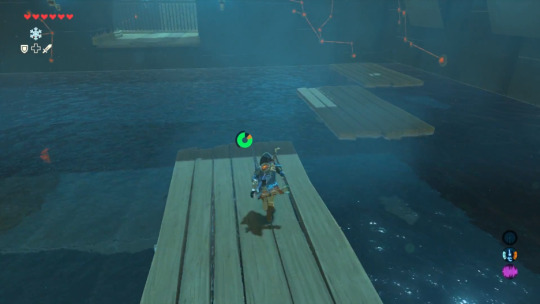
The name of this shrine truly suits its content, because it is Hilaraously easy. You just need to cross three small rivers, and there are even platforms to help you in case you have no idea what Cryonis is. For the final one, just stand on a platform and use a bomb or one of the five unneeded explosive barrels floating around to break the cracked wall and that’s it. Shrine done. Free orb. This may be the easiest shrine of the entire game, not counting the blessing ones, and not in a good way.
And that’s my opinion! Tweet me if you agree or disagree. We can meet up to discuss or fight merciless depending on your intentions. See you on the next Breath of the Wild list!
NEXT LIST: Top 5 Best and Worst Shrine Quests

5 notes
·
View notes
Text
3 Controllable Assets Every Sports Organization Should Be Investing In
I’ve been pushing the idea of controllable assets for sports organizations for a while now.
My emphasis on this topic started with my conversation with Ian Taylor on my podcast, The Business of Fun. In our conversation, Ian emphasized the role that email marketing plays in his partners’ success of selling tickets consistently.
He also pointed out that even I’m guilty of putting too much focus on sales tactics.
I’m a convert to controllable assets and I have 3 that I highlight regularly:
My podcast, The Business of Fun.
My newsletter, The Business of Value.
My blog which you are reading now.
In many cases, if we don’t have these things that we own and control, we are at the whims of algorithms, platform popularity, and other outside forces that can drive us into a frenzy of chasing our tails to keep up tactically.
Organizations around the world can create all kinds of assets that they can use to communicate with their fans, ticket buyers, and prospective customers, but I want to focus on 3 that offer the highest value and can be implemented pretty quickly.
Email lists
Mailing lists
Memberships/Fan Clubs
Let me explain why I think these are important for sports organizations:
Email lists are gold, still:
Every time we turn around it seems like someone is telling us we have to get on the newest platform.
But do we really?
I’d say in many cases the answer is no.
You can have 1,000,000 Facebook fans with 1,000,000,000 likes and it means absolutely nothing because they can change the algorithm so that your content and posts are buried, your fans may not open Facebook, or some other factor could come into play.
The numbers bear out that people still use email.
About 20 years ago, Seth Godin coined the term “permission marketing” and his idea was that marketing worked best when it was expected, relevant, and meaningful to the person receiving it.
To me, this hypothesis has held up well because we see how the average consumer is inundated with over 5,000 demands for their attention every day.
Does this mean people are paying attention to each of these demands?
No.
Just the opposite.
In most cases, people are getting better at tuning these requests out.
The thing about email is that people still look at their email. They may be frustrated by how much they get, but they still check it.
This is an opportunity because you should be in people’s inboxes with relevant, valuable, and expected messages.
Two examples of this that reflect this point:
First, each year around my birthday, a baseball team sends me an email…it is typically the only one I get each year from this team with a discount for tickets in the future as a present.
It fails with me for a number of reasons:
I’m out of market now.
I only get one message a year.
Tickets on-sale until months later.
Unfortunately, this is the nature of most of the communications that I see from a lot of organizations.
An example of a team that does email marketing well: Tottenham Hotspur.
The second example is from my own newsletter.
I had a colleague from a MLB team tell me recently that during the middle of the season when things are hectic and busy that one of the things he looks most forward to is receiving my email on Sunday because it inspires him and gives him new ideas.
I’ve managed to do 3 things here:
Be expected.
Be anticipated.
Be relevant.
If you have a fan base and you want to make sure you are getting your message to them consistently, invest time in building and deploying an email newsletter that is a little bit more than a score line and an ask to buy tickets.
It shouldn’t be hard to come up with incredible content that is unique and a draw to get people to open and engage with your newsletter in a way that will drive sales of merchandise, tickets, and other monetizable items.
Mailing lists:
I wrote about the Miami Marlins a few years back and the idea that they instituted to drive sales for their premium seating areas of “sprints”.
These sprints had a few elements that are reflective of the best practices in project management:
They were short and focused.
They were action-oriented.
They had clearly defined end dates and milestones.
This is all great, yeah!
But what is really important here is that they always kicked off the sprint with some physical mailing.
Depending on the target vertical, they may have sent something like a postcard, letter, or other typical mail.
In other instances, when the target warranted this approach, they might send out a baseball, a piece of memorabilia, or, in one instance, a base.
Where am I going with this?
The key action that drove the whole marketing campaign, the mailing at the start.
They needed to get people’s attention and cold calling, social media, email, or some other form of interruption marketing wasn’t having the desired impact.
So they targeted people with something physical.
This is important because as sports organizations, you should be using physical mail and physical assets to deepen your relationships with your fans.
If you don’t know where to start, you can use a B2B directory or buy a mailing list.
But pretty quickly you should take an approach like you might with email.
How is that?
Bribe people!
Offer them a t-shirt to sign up for your mailing list or your email list, a sticker, something…that will encourage them or require them to give you their addresses.
And, hopefully, both email and physical.
That way you can communicate directly with your best fans, buyers, and prospects because they’ve already signaled that they want to hear from you or are, at least, willing to hear from you.
Do you need ideas on this? Email me!? I’ve done some of the most creative work in political mail to get people’s attention for a candidate, issue, or initiative. If I can get people to pay attention to that stuff…anything is possible.
Besides, do you think someone isn’t going to open a cool package or letter from your team?
My bet is that the open rates and response rates will blow the typical direct mail response rate of 1-2% out of the water.
Memberships & Fan Clubs:
If you follow me on Twitter, you’ll have noticed a picture I posted yesterday that mentioned it was fan club pack day at my house and my son was happier than I’ve seen lately.
And, he’s a happy kid.
Why?
His One Hotspur membership package came yesterday.
If you are in DC today and you see a 9-year-old running around with a Tottenham drawstring backpack and a soccer ball in it that’s really loud…he’s mine, I swear.
The thing is that in most cases, we aren’t really maximizing things like this to really be assets that we can use well.
Why?
I’m not sure.
I’ve mentioned this program a lot over the years because it was revolutionary at the time and I think it is still pretty unique as an example even 17-18 years later.
That’s the way that the Seattle Supersonics had a rewards program back when Howard Schultz first purchased the team.
What was unique about this program was that anyone could sign up and you’d be rewarded for your attendance at games.
After certain milestones, you’d receive a gift from the team like a discount, a free drink, a piece of merchandise, or something else that was meaningful.
I had season tickets for a few years after I moved to the Experience Music Project because my office was in the Seattle Center, I could make almost every game if I wanted to, and I love basketball.
Besides those things, the surprise and desire to see what you’d get next when you checked in at the game enticed me to jump through tremendous hurdles to scan my card.
If I had an event I was running or taking part in, I’d give my tickets to a friend under the provision that they needed to scan my card. I’d take a walk to the team store and make a purchase so I could gain access to the scanning location right inside the team store.
I mean, I did all kinds of things to be able collect scans and check-ins for all 41 home games and all the playoff games that season.
What slips me is what the ultimate payoff was, but I do know that it had something to do with a Supersonics sweatshirt that I’ve owned for 17 years and that is my most prized possession.
And, I still wear it.
I’ve gone on a tangent a little bit so that I could highlight how valuable having these programs can be.
The thing is that in 2001, the technology existed to create this kind of program.
What can we do today?
What can we reward?
What can we possibly encourage our fans and supporters to tell us about themselves and their devotion to us for the cost of a t-shirt, a beer, or some other token of our appreciation?
I’m not sure I have the answer to that, but I think they’d us a lot.
And, I think it is amazing that people aren’t spending more time on uncovering the answer.
The reality is I think that’s the case with all 3 of my examples.
What say you?
You’ll learn about controllable assets and more at my workshop in Melbourne, Australia on 18 November 2019. “Fan For Life: Creating and Keeping Modern Fans” is my first full-day workshop in Australia and it is going to be packed with ideas, actions, and examples that you can take back to your organization immediately to generate higher attendance, more attention, and increased revenue. I’m going to guess you’ll see a ROI from this workshop of 100-1, easily….so get your tickets today!
Please follow and like us:
3 Controllable Assets Every Sports Organization Should Be Investing In was originally published on Wakeman Consulting Group
#email marketing#fan clubs#marketing#memberships#Miami marlins#permission marketing#revenue#sales#Seattle Supersonics#seth godin#sports business#sports marketing#sportsbiz#strategy#Tottenham Hotspur
0 notes
Text
Nier: Minutiae [Friendly Fire - The Pod Units]
I finally played through both Nier and Nier: Automata this year, and I’ve been wanting to post my thoughts on them for a while. I think I’ll make this a series of posts so I can focus on particular themes and go in depth where I want to. Some of this might be really clumsy analysis, some of it might be me thinking about plot holes, and most of it might just be me gushing about little details sprinkled here and there throughout both games.
If you wanna read more of my rantings, I’m gonna assume you’ve played both games so spoilers after the jump.
Also, for clarity’s sake I’ll refer to the first game solely as Nier and the second game as Automata.
The YorHa androids may be the faces of Nier: Automata, but they wouldn’t be anywhere if it weren’t for the diligence of their ever-faithful Pod Units.
The Pods in Automata are the analogs to the Grimoires in Nier. They provide support fire and can deal out special attacks in the game known as Pod Programs. Pods orbit their androids like options in a shmup (makes sense considering the game is part-shmup, part-action game) and when you fire the Pod’s main guns an aiming reticle appears in the center of the screen and the camera behaves like a light third-person shooter.
I think the best part about the Pods that they finally integrated shooting and melee combat so seamlessly in such a way that no other stylish action games have yet to achieve.
Now, please understand what I’m saying: I don’t think Automata has the best combat of any action game; I just think that assigning the melee and the shooting mechanics to two separate elements working together actually synergizes far better than ascribing those mechanics to only one element and causing them to vie for priority.
Lemme explain myself:
Nier: Automata is a Platinum Games title, and they’re known for their stylish action games that focus on executing outrageous attacks and chaining them into spectacular combos against hordes of enemies. These types of games draw influence from Capcom’s action games, namely the Devil May Cry series and God Hand. DMC mixed melee combat with shooting but the thing to take note with the shooting mechanics is that it doesn’t have the free-form aiming you would expect to have in more shooter-focused games. Moreover, shooting is more of a supplementary attack to chain combos by juggling enemies or to hit enemies that are afar until you can close the distance between them and deal melee damage.
(DMC mixes melee combat and shooting, but you can’t attack with melee and guns simultaneously and both attacks are dependent on where Dante is facing.)
youtube
Platinum’s most well-known title before Automata is the Bayonetta series, and they expanded on DMC’s stylish action combat and merged the melee and gun mechanics by literally affixing guns to Bayonetta’s limbs so she can fire steams of bullets after she throws a punch or kick. Do note that Bayonetta can still fire guns as a separate action from her melee attacks. While it integrates both styles of combat into one one singular action, the shooting mechanics still have to submit to the melee mechanics and guns are still used either to juggle enemies or keep pressure when you can’t physically reach your target.
(You can follow up melee attacks with streams of gunfire, but the kung fu still takes priority over the gun fu.)
youtube
This type of gameplay isn’t just a house style; other studios have developed games that focus on stylish action and approach the melee-shooting dichotomy with varying degrees of influence for either style.
Lollipop Chainsaw was developed by Grasshopper Manufacture and its heroine Juliet is basically Buffy the Zomboid Slayer. It’s mostly melee-focused with special attention to Juliet’s signature weapon but it also has one ranged weapon called the Chainsaw Cannon that converts the chainsaw into a weak grenade launcher. This changes the style of play into a light third-person shooter with an over-the-shoulder camera to allow the player to aim their shots, something DMC and Bayonetta lack in their combat.
(Jump to 2:54 to see Juliet switch to her ranged attack. While you can control where your shots land, note that switching combat styles drastically affects Juliet’s movement and evasive capabilities)
youtube
Devil’s Third is a Valhalla Games title and traces its pedigree to the Ninja Gaiden series (FULL DISCLOSURE: I haven’t played the game myself and am basing my hot take on playthroughs I’ve watched). While it tries to cater to both hack ‘n slash and shooting mechanics, the game looks like it plays more as a third-person shooter with some fairly deep melee combat; not Ninja Gaiden deep, but just enough variety to mix up the gameplay if you’re either out of bullets or wanna start slicing up some dudes.
(Shooting factors a lot more in Devil’s Third’s gameplay, but there’s still a hard transition between melee and guns)
youtube
The thing to take away from all of these examples is that it’s always one character who has to juggle between performing melee attacks and shooting guns. Switching combat styles requires different animations for each style and even transitional animations when switching styles.
In Automata, the android is the one that deals melee damage and almost all of their combat animations are tied to their physical attacks. The orbiting Pod unit is the one that deals ranged damage and it can move separately from the android but remain fixed upon the player’s camera, which lets it function as a floating gun in a third-person shooter. It’s perfectly possible to have the android attack from one position while the Pod shoots in the opposite direction and since shooting requires no animation from the android it’s a free action for the player to engage without compromising their offensive and defensive potential.
(Jump to 1:19 to see 2B perform a combo string and follow it up with Pod fire.)
youtube
Now I’ve said that games prior to Automata have treated shooting and slashing as a dichotomy, as two entities struggling for dominance in design. Automata’s combat treats shooting and slashing as a tag-team, where one takes over when they can yield better results but both can work at the same time at any point. The example video above doesn’t show 2B and the Pod attacking at the same time, and the only way I could explain that is that the Gatling gun button is normally set to be on the right shoulder bumper/R1 button and it’s ergonomically unnatural for most players to hold that button down while mashing the face buttons and aiming via the right analog stick with their thumb from the same hand.
Now just because you can shoot and slash at the same time any time, that doesn’t mean you’ll remember to do it all the time. If Automata’s combat was an always-in-your-face melee affair, the shooting would submit to the melee just like the above other games in my examples. The shmup combat the game mixes in ensures that you won’t leave your Pod out of combat. You can shoot down most enemy shots and create your own path through their shot patterns, but there are some enemy shots that are immune to Pod bullets and require you to either juke them or perform evasive dodges around them. However, those shots can be wiped offscreen with melee attacks. So now melee has to submit as a supplementary action while shooting takes precedence during the shmup setpieces (however, just like what I had said about feeling unnatural to fire guns while swinging swords, I tended to keep forgetting that I could destroy all the bullets if I attacked because I was so dependent on dodging most attacks as a play style).
If it sounds like I’m talking Automata up at the expense of the other games, please understand that’s not my intention for this post. Automata’s combat is lighter than most Platinum games because it’s not just a stylish action game, but an open(ish) world action-JRPG and the controls also have to account for platforming and navigation. Level design in stylish action games usually feature big open arenas connected by corridors that can also feature - and usually do feature - combat to keep the player entertained. Automata’s more open setting and light emphasis on verticality means it must compromise depth in combat for the ability to move naturally in the world.
I wrote all these words because I think it was a stroke of genius to separate the sword and the gun and paradoxically they work even more fluidly than if they were forced to channel the same medium at the same time and in the same conditions. I could try to tie it back to my fascination with Nier and Automata’s theme of duality, but honestly this is all just a really florid way of restating the old adage “two heads are better than one.”
#nier#nier: automata#devil may cry#bayonetta#lollipop chainsaw#devil's third#my thoughts#thinking bout games
4 notes
·
View notes
Photo
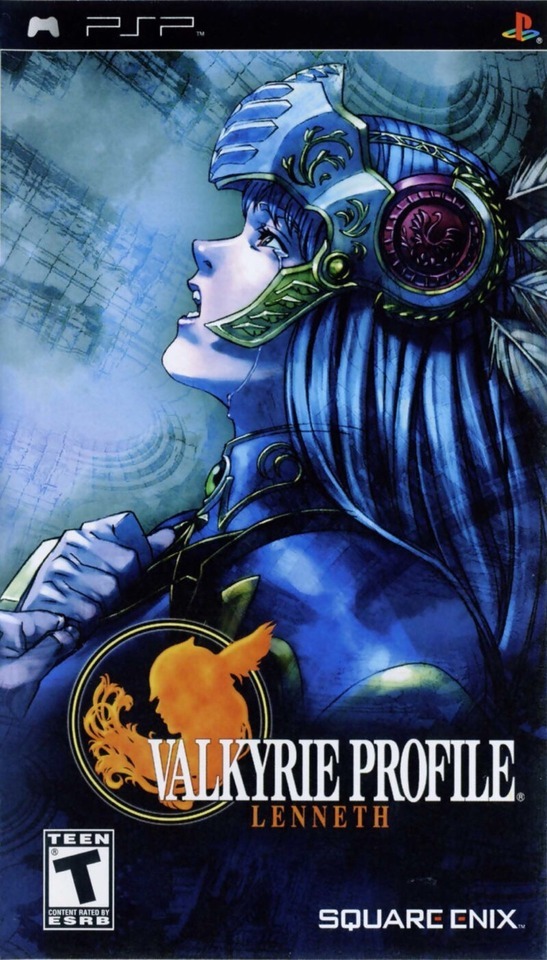
Valkyrie Profile: Lenneth
Release: 2006 (Original PSone in 2000)
My Rating: 7.5
The Long Story Short: Valkyrie Profile is at times frustrating and the best ending is obnoxiously difficult to achieve. Despite that it remains a fun, touching and beautiful rpg that withstands the test of time.
Review:
I’m trying to be as impartial as I can and so rated this game a 7.5 based on how I feel its merits stack up against its flaws. However, Valkyrie Profile is rated 10/10 in my heart and if I had to pick a favorite game this would be it. Valkyrie Profile: Lenneth is the 2006 PSP port of the PSone rpg Valkyrie Profile. The PSP port preceded a second entry in the series, and also helped to make the limited run of Valkyrie Profile more accessible. (To this day I have only ever seen one copy of the PSone edition in person and still kick myself for not buying it then. That was six years ago.) Luckily the PSP re-release is much easier to track down. It features re-translated names (Rucian became Lucian, ect.) and new CG cutscenes. Beyond that I’ve not noticed any changes.
The player takes the role of Lenneth Valkyrie, one of three sister goddesses who serve Odin, and sets out on a quest to pick the strongest recently deceased warriors to send to Valhalla to fight in a war between the gods. Over the course of eight chapters Valkyrie flies around the world map, visiting locations where she senses a warrior is about to die and recruiting them. She also has a secondary duty: purifying the world of evil spirits and the undead. This second task is what forms the game’s dungeons. Valkyrie profile is partially a 2D side scrolling platformer in the tradition of the Metroid-vania genre of games (This similarity is enhanced by the fact the game’s art direction and enemies often lean European-Gothic rather than Nordic which is a slightly disconcerting choice). Valkyrie maneuvers around dungeons with the ability to jump, slide and swing along overhead chains and ropes. Valkyrie Profile introduces new flavor to its platforming by use of crystals Valkyrie can shoot onto flat surfaces, including vertical walls. She can stand on them, explode them under her to propel her in the opposite direction or stand on a floating cloud of the resulting particles and even break them and use the pieces. The game uses this gimmick to wonderful effect, making it central to several puzzles. The dungeons in Valkyrie Profile are often fun and a nice exercise in puzzle solving, but sometimes become too esoteric to solve without help or sinking hours into them which can lead to a lot of frustration.
In these dungeons Valkyrie will encounter roaming enemies. She can freeze them with her crystals to avoid them or strike them with her sword to initiate combat. Valkyrie Profile has an interesting combat system in which each of four party members is assigned a button on the controller. Pressing the button for a character causes them to strike with their default attack. This is a simple system to get the hang of and the game slowly increases the complexity as enemies begin to get better at blocking and the player has to balance weapon power versus number of attacks. If the player chains enough attacks on an enemy they unleash a limit break unique to each warrior or a powerful magic attack. Chaining can be vital in late game. Just as important is the ability to perform overkill on enemies so that they drop items, experience multiplying crystals and gems that reduce the cool down time on magic and limit breaks.
All of this is done to train einherjar for Odin’s war. Lenneth is asked to send up at least one einherjar with specific skills every chapter. At the end of each chapter her performance is rated and she is given rewards of items and Materialization Points which are used to materialize items from the party menu in place of going to a store. All this is a very solid foundation but there are several touches that make this game fiddly to play, and makes the ‘good’ ending almost impossible to earn without a game guide to reference.
First of all there are three difficulty settings for the game that are complete misnomers. Easy features reduced difficulty but becomes perhaps the hardest in the long run as the reduced experience and item gain takes its toll on character growth. Additionally the ‘good’ ending isn’t available on easy. Normal is somewhat better balanced. However, hard is the only mode that lets you visit all the dungeons and recruit all of the characters in the game. The difficulty hike from normal to hard isn’t that pronounced but it is exacerbated by every recruited character starting at level one in hard mode. This sounds frustrating but in fact as the player clears dungeons and solves puzzles they will be rewarded with “event experience” that can be doled out to any party member at will. It’s not enough to catch a new character up with the rest of the party, but it is enough to get them in fighting shape or prep them for Valhalla. In some ways this is an advantage because a large part of character growth is determined by Capacity Points that they gain when they level up. These can be spent on improving einherjar’s personality traits and giving them both combat skills and knowledge skills that Freya requests. CP pools stop growing at 999 so if you recruit characters in normal mode they often have capped CP and have lost a lot of potential growth.
When it comes to story Valkyrie Profile believes in show rather than tell. Very little is said outright to the player about the machinations of the gods or the state of the human world, but through conversations the player witnesses in Valhalla and the situations Lenneth sees when she recruits einherjar stories begin to come together. Far more is implied than is ever said so it’s easy to pick up new details with every playthrough, particularly if you also play the sequel. This is good because unless you manage to complete to rather unintuitive steps to reach the good ending the overarching plot of the game is pretty dry. The story is communicated mostly through dialogue, and unfortunately it’s partially acted. Unfortunately because all the text appears on screen anyway and much of the voice acting is wince-inducingly bad. Adding worse to bad, even in the Lenneth port, a great deal of the Japanese to English translation came out somewhat stilted and awkward.
Luckily the music of Valkyrie Profile is well worth listening to. It features several very nice pieces that straddle the line between retro synth and more modern orchestral soundtracks. The original game played most of its major scenes out in the 2D style of its gameplay, with a few CG cutscenes to display large set pieces and events that don’t feature any people in them. The Lenneth port adds a handful of pretty CG cutscenes to add flavor to major events (for the most part. Some choices for the CG were a little odd to me.) I found them very pretty and nice touches.
Valkyrie Profile is one of those games you either love or you hate. It has some fun hooks hampered by esoteric puzzles and a main story you need to jump through hoops to get to. That said, the story is worth tracking down, and with some patience, the dungeon puzzles are worth solving. Valkyrie Profile creates an interesting and complicated world that had amazing potential for more sequels than it’s been given thus far. I have my fingers forever crossed in hopes of more.
#Valkyrie profile#Valkyrie Profile Lenneth#Valkyrie Profile Lenneth Review#video game review#top ten games list
3 notes
·
View notes
Text
Is SEO Dead? (A Data-Driven Answer)
email marketing drip campaign cadence
SEO has been changing drastically over the years.
In 2010, Google made 516 algorithm changes. That number increased to 1,653 in 2016 and to 3,234 in 2018. We don’t have data for the last couple of years, but still, you can bet that the number is continually going up.
With over 9 algorithm changes a day, it’s safe to say that it is no longer easy to manipulate or game Google.
So, is SEO dead?
Well, let’s look at the data and from there I’ll show you what you should do.
Is SEO dead?
Do you know how many searches take place on Google each day?
Roughly 5.6 billion searches per day.
That’s roughly 2 trillion searches each year.
Although that’s a lot of searches, there is also a lot of content being created.
There are roughly a billion blogs on the web.
There are so many blogs that you can find an excessive amount of content on most topics out there.
For example, if you look at the long-tail phrase, “what is digital marketing”, there are only 11,300 global searches a month but a whopping 665,000 pieces of content trying to answer that question.
In other words, the supply is much greater than the demand.
You’ll see even more of this for head terms. Just look at the phrase “banana”:
640,300 global searches seem like a high number but there are 880,000,000 million results. Sure, some of those results may not be on the food, banana, but still, that’s a lot of content compared to the search volume.
You can still find search phrases where there is more search volume than content but the trend is continually increasing in which content production is exceeding search demand.
On top of that, Google is turning into an answer engine in which they are answering people’s questions without them having to go to a website.
According to Dejan SEO, they saw CTRs drastically decrease once Google started answering questions. Just look at this weather search query:
Their clicks from weather-related queries went from 46% all the way down to 7%.
This trend has become so common that the percentage of traffic that Google drives to organic listings (SEO results) has been decreasing over time.
So, does this mean SEO is dead?
It’s actually the opposite.
SEO is not dead
With all of the data, how can that be the case?
First off, all marketing channels become statured over time. It’s just a question of when.
You can say the same thing about Facebook, Instagram, Twitter, and even email marketing.
Heck, just look at the image below. It was the first banner ad on the Internet.
Can you guess what company created that banner ad? It was ATT.
Of the people who saw it, 44% of them clicked on it. Now banner ads generate an average click-through rate of 0.5%.
That’s an enormous drop.
And, as I mentioned above, it’s with all channels. Just look at Instagram engagement rates:
It doesn’t matter if it is a sponsored post or an organic post, the trend on Instagram is that engagement is going down.
That’s why you are seeing people like Gary Vaynerchuk and Grant Cardone promoting their phone numbers all over Instagram.
That way they can communicate with their fans directly without having to deal with algorithms or platforms decreasing their engagement.
But even with those decreasing numbers, you are seeing sponsored posts on Instagram surging by 150%.
In other words, people are still spending money because they are seeing an ROI or generating enough value in their eyes.
And the same is happening with digital ad spending.
The numbers are on the rise because companies are generating an ROI.
So, how is SEO still not dead?
As I explained above, just because the metrics aren’t going in your favor doesn’t mean that a channel is dead.
Just look at my search traffic on NeilPatel.com.
Not only do I have to deal with Google’s algorithm like you, but my competition includes other marketers who know what I know… yet I am still able to grow my search traffic even with Google’s decreasing CTRs.
When you look at search as a whole (and I am not only talking about on Bing and Google as people also search on other sites and platforms as well) Google still dominates market share with a whopping 94%.
People still use Google and prefer them as their method of search. But what’s changed is how Google is being used.
It used to be where you would use platforms like Instagram for discovery and Google for commerce (purchasing).
The trend has switched over the years in which Instagram is being heavily used for commerce and Google is mainly used as a discovery engine.
Just look at this case study by Olay.
Olay sells products related to skincare. One of their products happens to reduce darkness under your eyes.
So, they used to push heavily on ads that sold their products directly.
But the moment they changed their ads to focus on education by teaching people how to reduce dark circles under their eyes instead of forcing people to buy their products, their ROI went through the roof.
By sending people to educational-based content first (and then selling through the content), they were able to increase click-throughs by 87%, decrease their cost per click by 30%, and increase conversions by 100%.
This is a prime example of how more people are using Google as a discovery engine first instead of a commerce engine.
SEO isn’t dying it is just changing
Now that you know that Google is shifting to a discovery engine (for both paid and organic listings), there are a few other things you need to know if you want to dominate the organic listings.
1: Google wants to rank sites you want to see
Their algorithm core focus isn’t backlinks or keyword density, or a specific SEO metric… the focus is on the user experience.
If a site has millions of backlinks but users hate it, the site won’t rank well in the long run.
Look at this case study of the “best grilled steaks.”
Rand Fishkin had all of his social followers do the following:
Within 70 minutes, the listing jumped to the top spot.
This is what I mean by user signals. You, the end-user, control how Google adjusts rankings.
2. People don’t just use Google. Google gathers data from everywhere.
Google knows you spend hours a day on your mobile device and hours on other sites and applications that aren’t controlled or owned by Google.
So, when they are figuring out what to rank and where to rank it, they aren’t just looking at their own dataset.
They crawl things like social media and use social signals to help them better improve their results.
For example, here is a case study on how Google is using social media for search discovery.
Even if you hate the social web, you need to use it more. Not only can it help with your site’s indexing but it can also help with brand building, which indirectly will help boost your rankings as well.
Here are some articles to follow to help boost your social media presence:
How to Gain 1,260 Instagram Followers per Week
16 Powerful Facebook Marketing Tips That Actually Work
The Complete Guide to Using Twitter to Grow Your Business
9 LinkedIn Marketing Tips
How to Hack YouTube
The Ultimate Guide to Pinterest Marketing
4 Principles of Successful Snapchat Marketing
3. Google loves brands
If you don’t believe me, just look at these quotes from Google’s ex-CEO and ex-head of webspam.
They both believe in brands.
As your brand grows, you’ll find that your rankings will climb as well.
You saw my search traffic stats earlier in the post, but here’s a breakdown of how many people found my site by searching for my name in the last 7 days.
And that number doesn’t even include the misspellings. You would be shocked at how many people spell my name as “niel” instead of “neil.”
Google loves brands. Heck, when you type in “men’s running shoes,” they even have Nike, Adidas, and Asics there.
Branded search volume is more correlated with rankings than links or domain authority.
If you want to build a brand, focus on the social media articles I linked to above and follow the brand building articles below:
How to Dominate Google
How to Increase Rankings Through Brand Mentions
How to Use SEO to Build Your Brand
The Future of SEO
If you are still struggling to build a brand, talk to one of my team members about our Digital PR.
4. Focus on a niche
Do you remember the old-school site About.com?
Over time, About.com tanked in terms of their Google rankings and the business was dying. There were a few reasons why:
The site didn’t focus on a single niche… it was about everything
The content was mediocre. They didn’t go in-depth but instead just kept things surface level.
They had too much content that no one cared to read.
They decided to rebrand as Dotdash and start niching down. So they took the content on About.com and split it into six specific vertical sites.
When doing this they found that a lot of the content didn’t fit into those 6 verticals or wasn’t up to their new quality standard. This caused them them delete roughly 900,000 articles.
From the data, you can see that they got much more traffic by splitting up their content into niched-down sites.
It was so successful that they took one of their new vertical sites and broke it down further into three niche sites. Here were the results:
This helped them grow their revenue by 140%.
If you want to do well in today’s world of SEO, focus on one niche. Google prefers topic-specific sites because that’s what you and everyone else loves.
Just think of it this way… would you rather read medical advice from About.com or WebMD?
WebMD of course.
5. Future is personalization
Have you noticed that when you search on Google the results you see are different than the results of your friends?
It’s because Google is trying to personalize the results to you.
Not just on Google search but anywhere you use a Google device… from a smartphone to Google Home to even their autonomous cars.
With all of the data they are gathering, they are better suited to understand your preferences and then modify the results to that.
Just think of it this way: Every time you visit a place and you are carrying your mobile phone (especially if it is an Android device), Google may be able to potentially use that information to tailor results to you.
With your website, don’t try and show everyone the same message. If you personalize your experience to each and every user, you will be able to rank better in the long run as it will improve your user metrics.
A good example of this is on my blog.
Right when you land there, I let you pick the type of content you want to see and then the page adapts to your interest.
It’s actually the most clicked area on the blog, believe it or not.
Conclusion
SEO is not dead, it’s just changing.
Sure, click-through rates are going down and Google keeps adjusting its algorithm but that’s to be expected.
Google has made it so you can easily target your ideal customer through SEO or paid ads.
It used to be much more difficult before they came along. That’s why they are able to generate over 100 billion dollars a year in advertising revenue.
Don’t worry about things that aren’t in your control. Instead, start adapting or your traffic and business will be dead.
What do you think about the changing SEO landscape?
Google
0 notes
Text
Is SEO Dead? (A Data-Driven Answer)
SEO has been changing drastically over the years.
In 2010, Google made 516 algorithm changes. That number increased to 1,653 in 2016 and to 3,234 in 2018. We don’t have data for the last couple of years, but still, you can bet that the number is continually going up.
With over 9 algorithm changes a day, it’s safe to say that it is no longer easy to manipulate or game Google.
So, is SEO dead?
Well, let’s look at the data and from there I’ll show you what you should do.
Is SEO dead?
Do you know how many searches take place on Google each day?
Roughly 5.6 billion searches per day.
That’s roughly 2 trillion searches each year.
Although that’s a lot of searches, there is also a lot of content being created.
There are roughly a billion blogs on the web.
There are so many blogs that you can find an excessive amount of content on most topics out there.
For example, if you look at the long-tail phrase, “what is digital marketing”, there are only 11,300 global searches a month but a whopping 665,000 pieces of content trying to answer that question.
In other words, the supply is much greater than the demand.
You’ll see even more of this for head terms. Just look at the phrase “banana”:
640,300 global searches seem like a high number but there are 880,000,000 million results. Sure, some of those results may not be on the food, banana, but still, that’s a lot of content compared to the search volume.
You can still find search phrases where there is more search volume than content but the trend is continually increasing in which content production is exceeding search demand.
On top of that, Google is turning into an answer engine in which they are answering people’s questions without them having to go to a website.
According to Dejan SEO, they saw CTRs drastically decrease once Google started answering questions. Just look at this weather search query:
Their clicks from weather-related queries went from 46% all the way down to 7%.
This trend has become so common that the percentage of traffic that Google drives to organic listings (SEO results) has been decreasing over time.
So, does this mean SEO is dead?
It’s actually the opposite.
SEO is not dead
With all of the data, how can that be the case?
First off, all marketing channels become statured over time. It’s just a question of when.
You can say the same thing about Facebook, Instagram, Twitter, and even email marketing.
Heck, just look at the image below. It was the first banner ad on the Internet.
Can you guess what company created that banner ad? It was ATT.
Of the people who saw it, 44% of them clicked on it. Now banner ads generate an average click-through rate of 0.5%.
That’s an enormous drop.
And, as I mentioned above, it’s with all channels. Just look at Instagram engagement rates:
It doesn’t matter if it is a sponsored post or an organic post, the trend on Instagram is that engagement is going down.
That’s why you are seeing people like Gary Vaynerchuk and Grant Cardone promoting their phone numbers all over Instagram.
That way they can communicate with their fans directly without having to deal with algorithms or platforms decreasing their engagement.
But even with those decreasing numbers, you are seeing sponsored posts on Instagram surging by 150%.
In other words, people are still spending money because they are seeing an ROI or generating enough value in their eyes.
And the same is happening with digital ad spending.
The numbers are on the rise because companies are generating an ROI.
So, how is SEO still not dead?
As I explained above, just because the metrics aren’t going in your favor doesn’t mean that a channel is dead.
Just look at my search traffic on NeilPatel.com.
Not only do I have to deal with Google’s algorithm like you, but my competition includes other marketers who know what I know… yet I am still able to grow my search traffic even with Google’s decreasing CTRs.
When you look at search as a whole (and I am not only talking about on Bing and Google as people also search on other sites and platforms as well) Google still dominates market share with a whopping 94%.
People still use Google and prefer them as their method of search. But what’s changed is how Google is being used.
It used to be where you would use platforms like Instagram for discovery and Google for commerce (purchasing).
The trend has switched over the years in which Instagram is being heavily used for commerce and Google is mainly used as a discovery engine.
Just look at this case study by Olay.
Olay sells products related to skincare. One of their products happens to reduce darkness under your eyes.
So, they used to push heavily on ads that sold their products directly.
But the moment they changed their ads to focus on education by teaching people how to reduce dark circles under their eyes instead of forcing people to buy their products, their ROI went through the roof.
By sending people to educational-based content first (and then selling through the content), they were able to increase click-throughs by 87%, decrease their cost per click by 30%, and increase conversions by 100%.
This is a prime example of how more people are using Google as a discovery engine first instead of a commerce engine.
SEO isn’t dying it is just changing
Now that you know that Google is shifting to a discovery engine (for both paid and organic listings), there are a few other things you need to know if you want to dominate the organic listings.
1: Google wants to rank sites you want to see
Their algorithm core focus isn’t backlinks or keyword density, or a specific SEO metric… the focus is on the user experience.
If a site has millions of backlinks but users hate it, the site won’t rank well in the long run.
Look at this case study of the “best grilled steaks.”
Rand Fishkin had all of his social followers do the following:
Within 70 minutes, the listing jumped to the top spot.
This is what I mean by user signals. You, the end-user, control how Google adjusts rankings.
2. People don’t just use Google. Google gathers data from everywhere.
Google knows you spend hours a day on your mobile device and hours on other sites and applications that aren’t controlled or owned by Google.
So, when they are figuring out what to rank and where to rank it, they aren’t just looking at their own dataset.
They crawl things like social media and use social signals to help them better improve their results.
For example, here is a case study on how Google is using social media for search discovery.
Even if you hate the social web, you need to use it more. Not only can it help with your site’s indexing but it can also help with brand building, which indirectly will help boost your rankings as well.
Here are some articles to follow to help boost your social media presence:
How to Gain 1,260 Instagram Followers per Week
16 Powerful Facebook Marketing Tips That Actually Work
The Complete Guide to Using Twitter to Grow Your Business
9 LinkedIn Marketing Tips
How to Hack YouTube
The Ultimate Guide to Pinterest Marketing
4 Principles of Successful Snapchat Marketing
3. Google loves brands
If you don’t believe me, just look at these quotes from Google’s ex-CEO and ex-head of webspam.
They both believe in brands.
As your brand grows, you’ll find that your rankings will climb as well.
You saw my search traffic stats earlier in the post, but here’s a breakdown of how many people found my site by searching for my name in the last 7 days.
And that number doesn’t even include the misspellings. You would be shocked at how many people spell my name as “niel” instead of “neil.”
Google loves brands. Heck, when you type in “men’s running shoes,” they even have Nike, Adidas, and Asics there.
Branded search volume is more correlated with rankings than links or domain authority.
If you want to build a brand, focus on the social media articles I linked to above and follow the brand building articles below:
How to Dominate Google
How to Increase Rankings Through Brand Mentions
How to Use SEO to Build Your Brand
The Future of SEO
If you are still struggling to build a brand, talk to one of my team members about our Digital PR.
4. Focus on a niche
Do you remember the old-school site About.com?
Over time, About.com tanked in terms of their Google rankings and the business was dying. There were a few reasons why:
The site didn’t focus on a single niche… it was about everything
The content was mediocre. They didn’t go in-depth but instead just kept things surface level.
They had too much content that no one cared to read.
They decided to rebrand as Dotdash and start niching down. So they took the content on About.com and split it into six specific vertical sites.
When doing this they found that a lot of the content didn’t fit into those 6 verticals or wasn’t up to their new quality standard. This caused them them delete roughly 900,000 articles.
From the data, you can see that they got much more traffic by splitting up their content into niched-down sites.
It was so successful that they took one of their new vertical sites and broke it down further into three niche sites. Here were the results:
This helped them grow their revenue by 140%.
If you want to do well in today’s world of SEO, focus on one niche. Google prefers topic-specific sites because that’s what you and everyone else loves.
Just think of it this way… would you rather read medical advice from About.com or WebMD?
WebMD of course.
Another thing they did
5. Future is personalization
Have you noticed that when you search on Google the results you see are different than the results of your friends?
It’s because Google is trying to personalize the results to you.
Not just on Google search but anywhere you use a Google device… from a smartphone to Google Home to even their autonomous cars.
With all of the data they are gathering, they are better suited to understand your preferences and then modify the results to that.
Just think of it this way: Every time you visit a place and you are carrying your mobile phone (especially if it is an Android device), Google may be able to potentially use that information to tailor results to you.
With your website, don’t try and show everyone the same message. If you personalize your experience to each and every user, you will be able to rank better in the long run as it will improve your user metrics.
A good example of this is on my blog.
Right when you land there, I let you pick the type of content you want to see and then the page adapts to your interest.
It’s actually the most clicked area on the blog, believe it or not.
Conclusion
SEO is not dead, it’s just changing.
Sure, click-through rates are going down and Google keeps adjusting its algorithm but that’s to be expected.
Google has made it so you can easily target your ideal customer through SEO or paid ads.
It used to be much more difficult before they came along. That’s why they are able to generate over 100 billion dollars a year in advertising revenue.
Don’t worry about things that aren’t in your control. Instead, start adapting or your traffic and business will be dead.
What do you think about the changing SEO landscape?
The post Is SEO Dead? (A Data-Driven Answer) appeared first on Neil Patel.
0 notes